The good news is that I've sold another story. This one to Andromeda Spaceways In-Flight Magazine. Some time ago, David Conyers and I wrote a Harrison Peel story named “The Masked Messenger,” now it has found a home.
The other good news is that I have sold “N is for Neville” to Miskatonic River Press's Dead But Dreaming 2. David Conyers, Erik T. Johnson and Wilum Pugmire have also sold stories to this anthology, so I will be in excellent good company.
The personal blog of John Goodrich, including, but not limited to kaiju film and comics involving swamp creatures.
Friday, December 31, 2010
Thursday, December 30, 2010
Chem Lab, Isolation of Caffeine from Tea
Chemistry is the visually iconic science. When people in a film "do SCIENCE!" it's usually with the distinctive apparatus of chemistry. When Herbert West is down in his lab doing Mad Science, it’s with a chemistry set. Yeah, he’s got a head in a pan, but notice the chemistry glassware that’s littering his work area.
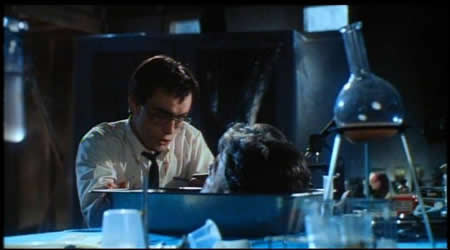
That’s because chemistry deals with physical matter, and often needs to separate one substance from another.
So I came to chemistry lab and chose my station. And then I looked up and saw this:

That’s the ceiling. Clearly, someone had an interesting (read: explosive. The ceiling is a good twelve to fifteen feet above my head) chemical reaction. A reminder, or maybe a hope, that something like that could happen to me.
The lab I took pictures of is an isolation of caffeine from tea. So the first thing we did was a good, hot cup of tea. This being chemistry, we have to do it with beakers and hot plates, and there’s just a horrible amount of stuff hanging around, including an ice bath and a filter and vile stuff (how vile? Just wait, I’ve got a shot of the label of one of the ingredients we used) that we’re going extract the caffeine with.
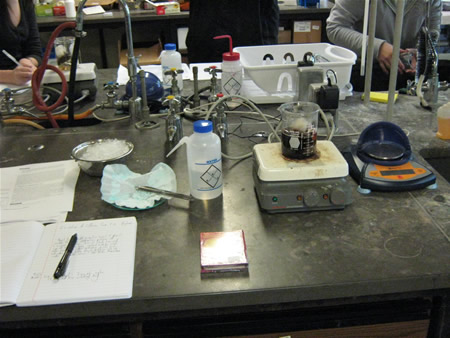
Having boiled the tea to get all the fascinating organic compounds out of it, we add a binding agent. Helpful hint to those of you who have not taken chemistry: hot glass looks exactly like cold glass. If you don’t know what temperature the glass is, put your hand near it first.
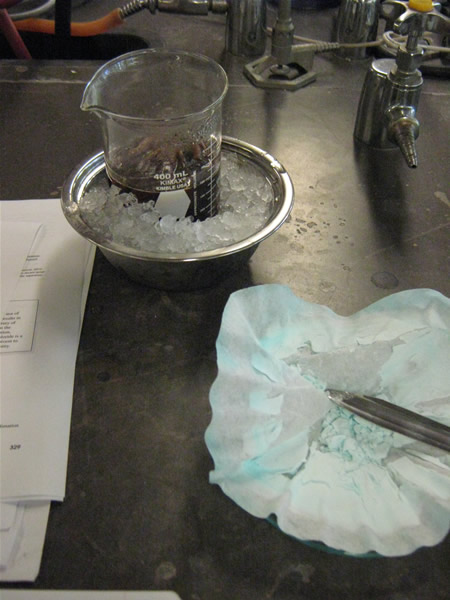
Having brewed tea, and added chemicals to make it completely undrinkable (the modern method for extracting caffeine from tea involves dipping it in high-pressure liquid carbon dioxide, rather than using a ethyl acetate, which is why decaffeinated tea and coffee no longer taste like ethyl acetate), we cool it in an ice bath.

We then filter the result into a Buchner flask. This removes some of what we added to the tea. The hose is a vacuum pump attached to the water faucet, more to encourage the tea through the filter than anything else.
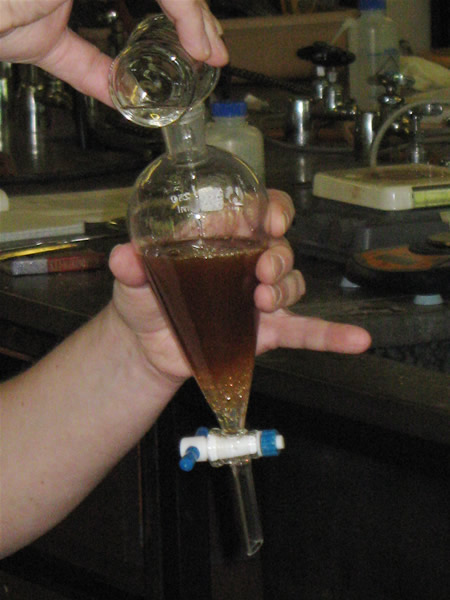
Now we get to the cool glassware. The shape of the seperatory funnel helps separate the liquid by density. The denser stuff goes to the bottom, and the lighter stuff can sit on the top. You can see it beginning to separate in the photo. We use the stopcock to pour the clear stuff out the bottom, while making sure we don’t get any of the tea-colored liquid. We end up with a small amount of clear liquid in to a beaker. We then set this under the hood and leave it to evaporate.
The rest of the class comes back in a week. I spy on it the next day. The liquid has evaporated, leaving behind a chalky white substance.

We think it’s caffeine, but how can we be sure? And how will we be able to remove any impurities? The answer appears to be a crack pipe.

But it’s not really a crack pipe. It’s a complex piece of glassware called a cold finger. We shove ice down the top of it which has a long extrusion into the bottom cavity. So we can heat something and provide it with a cold surface to reform onto after it has sublimated. Caffeine will burn off the crystals we have and stick to the cold finger, where the impurities shouldn’t. The stem to the side will be attached to a vacuum pump so that this can be achieved at low pressure.
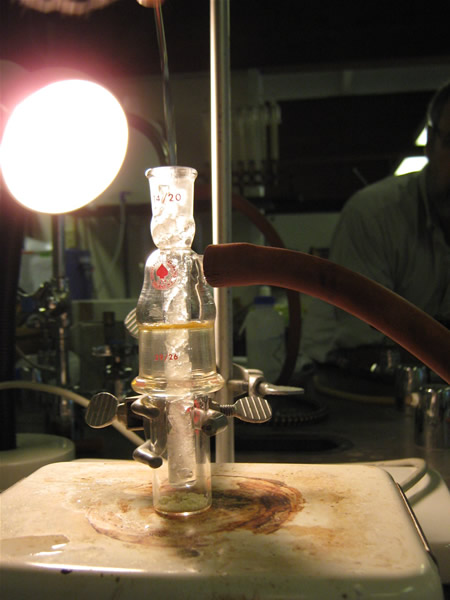
Here you can see the ice going down the cold finger, and there is our collection of suspicious white crystal at the bottom. And it’s resting on a hot plate. I swear that the rubber hose is not feeding into someone’s lungs.
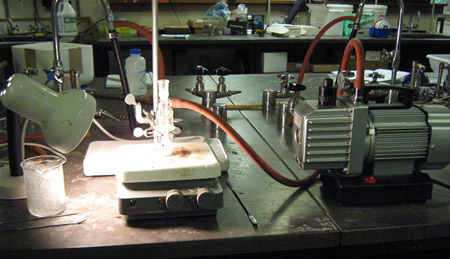
See?
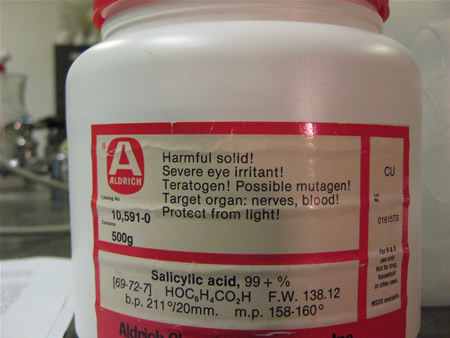
The reason we all wear safety goggles is because we’re noodling around with stuff like this. No wonder Peter Parker got his fame from being in a science lab. Where else are you going to find an off-the-shelf mutagen?

After weighing how much stuff we have scraped off the interior of thecrack pipe cold finger, we dissolve it. We’re dealing with minuscule amounts by now.
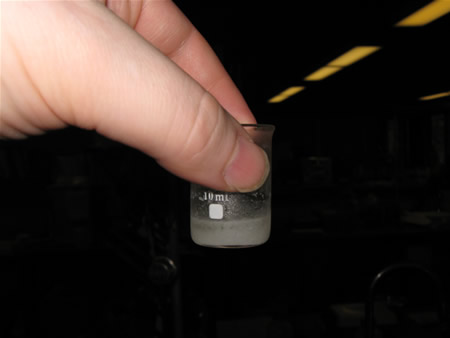
This is a 10 mL beaker, and there might actually be 1 mL in it. If Barbie ever does science in her Malibu Dream College, she’ll come with an assortment of 10 mL beakers. Probably in fabulous colors.

This piece of equipment was designed by a sadist. It’s ostensibly so that you can look at the eensy weensy sample you’ve put in this machine and see exactly when it melts. The melting point of something is a good indication that it is what you think it is. But that’s not the fun part.
You see that yellow sticker? It says “Caution Unit Hot.” Do you know what’s directly above that sticker? The eyepiece. Will the chemistry student be able to look through the eyepiece without burning the shit out of their cheeks? Ho ho ho! Science has a sense of humor!
There is another way to check to make sure that the caffeine we’ve labored over so hard is in fact caffeine. With a Nuclear Magnetic Resonator.
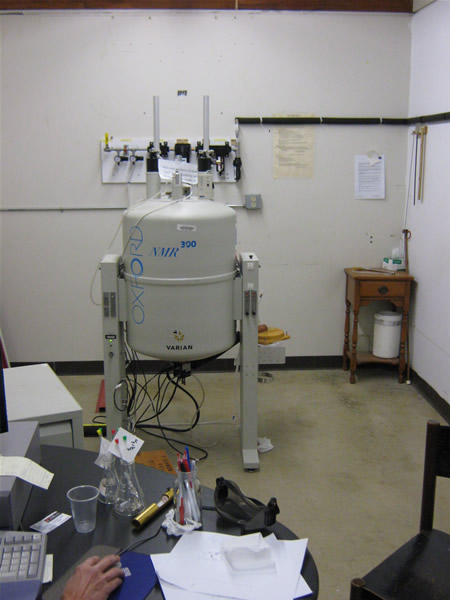
One of these. An advantage to taking chemistry at Bennington College is that they are proud of their science program, and are willing to plunk down the 300 large it takes to own Nuclear Magnetic Resonator. And the additional 12 K per hear it takes to feed the thing helium coolant. So at the end of this lab, yes, I got to drive the school’s NMR.
Now, interpreting the results was surprisingly difficult for something so damn advanced. The NMR tells you about the molecules you’re dealing with indirectly. Your results are based on the hydrogen atoms that are bonded to the atoms next to the one you’re looking at. Is that clear? So it will tell you, for example, that you’ve got eight hydrogens near a particular nucleus, and you have to parse out what atoms they’re near and how many go on each one. For the whole chain. It’s surprisingly like a cryptography sequence.
So at the end, hurrah, we have managed to isolate this stuff:
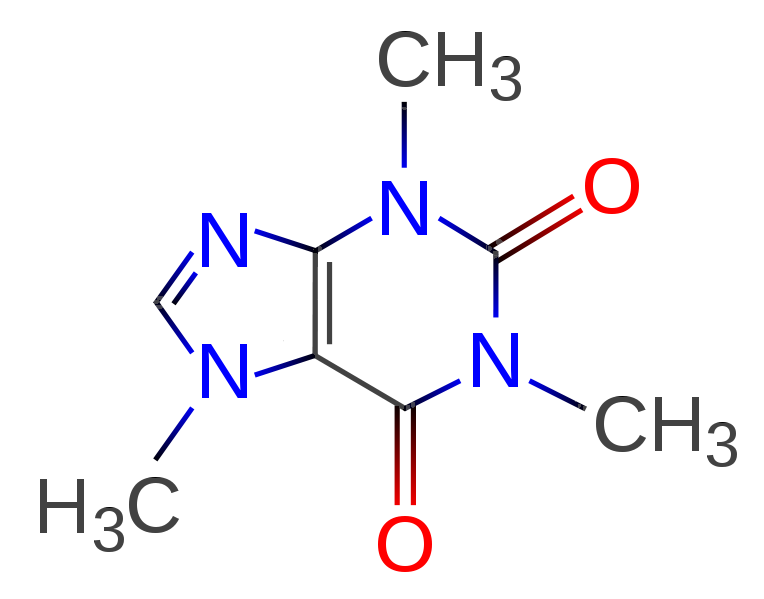
This is a sequence of three consecutive labs, all of which built on each other. I figured if I was going to photograph and share, I might as well share the most impressive-looking one.
Tomorrow, the Good News.

That’s because chemistry deals with physical matter, and often needs to separate one substance from another.
So I came to chemistry lab and chose my station. And then I looked up and saw this:

That’s the ceiling. Clearly, someone had an interesting (read: explosive. The ceiling is a good twelve to fifteen feet above my head) chemical reaction. A reminder, or maybe a hope, that something like that could happen to me.
The lab I took pictures of is an isolation of caffeine from tea. So the first thing we did was a good, hot cup of tea. This being chemistry, we have to do it with beakers and hot plates, and there’s just a horrible amount of stuff hanging around, including an ice bath and a filter and vile stuff (how vile? Just wait, I’ve got a shot of the label of one of the ingredients we used) that we’re going extract the caffeine with.

Having boiled the tea to get all the fascinating organic compounds out of it, we add a binding agent. Helpful hint to those of you who have not taken chemistry: hot glass looks exactly like cold glass. If you don’t know what temperature the glass is, put your hand near it first.

Having brewed tea, and added chemicals to make it completely undrinkable (the modern method for extracting caffeine from tea involves dipping it in high-pressure liquid carbon dioxide, rather than using a ethyl acetate, which is why decaffeinated tea and coffee no longer taste like ethyl acetate), we cool it in an ice bath.

We then filter the result into a Buchner flask. This removes some of what we added to the tea. The hose is a vacuum pump attached to the water faucet, more to encourage the tea through the filter than anything else.

Now we get to the cool glassware. The shape of the seperatory funnel helps separate the liquid by density. The denser stuff goes to the bottom, and the lighter stuff can sit on the top. You can see it beginning to separate in the photo. We use the stopcock to pour the clear stuff out the bottom, while making sure we don’t get any of the tea-colored liquid. We end up with a small amount of clear liquid in to a beaker. We then set this under the hood and leave it to evaporate.
The rest of the class comes back in a week. I spy on it the next day. The liquid has evaporated, leaving behind a chalky white substance.

We think it’s caffeine, but how can we be sure? And how will we be able to remove any impurities? The answer appears to be a crack pipe.

But it’s not really a crack pipe. It’s a complex piece of glassware called a cold finger. We shove ice down the top of it which has a long extrusion into the bottom cavity. So we can heat something and provide it with a cold surface to reform onto after it has sublimated. Caffeine will burn off the crystals we have and stick to the cold finger, where the impurities shouldn’t. The stem to the side will be attached to a vacuum pump so that this can be achieved at low pressure.

Here you can see the ice going down the cold finger, and there is our collection of suspicious white crystal at the bottom. And it’s resting on a hot plate. I swear that the rubber hose is not feeding into someone’s lungs.

See?

The reason we all wear safety goggles is because we’re noodling around with stuff like this. No wonder Peter Parker got his fame from being in a science lab. Where else are you going to find an off-the-shelf mutagen?

After weighing how much stuff we have scraped off the interior of the

This is a 10 mL beaker, and there might actually be 1 mL in it. If Barbie ever does science in her Malibu Dream College, she’ll come with an assortment of 10 mL beakers. Probably in fabulous colors.

This piece of equipment was designed by a sadist. It’s ostensibly so that you can look at the eensy weensy sample you’ve put in this machine and see exactly when it melts. The melting point of something is a good indication that it is what you think it is. But that’s not the fun part.
You see that yellow sticker? It says “Caution Unit Hot.” Do you know what’s directly above that sticker? The eyepiece. Will the chemistry student be able to look through the eyepiece without burning the shit out of their cheeks? Ho ho ho! Science has a sense of humor!
There is another way to check to make sure that the caffeine we’ve labored over so hard is in fact caffeine. With a Nuclear Magnetic Resonator.

One of these. An advantage to taking chemistry at Bennington College is that they are proud of their science program, and are willing to plunk down the 300 large it takes to own Nuclear Magnetic Resonator. And the additional 12 K per hear it takes to feed the thing helium coolant. So at the end of this lab, yes, I got to drive the school’s NMR.
Now, interpreting the results was surprisingly difficult for something so damn advanced. The NMR tells you about the molecules you’re dealing with indirectly. Your results are based on the hydrogen atoms that are bonded to the atoms next to the one you’re looking at. Is that clear? So it will tell you, for example, that you’ve got eight hydrogens near a particular nucleus, and you have to parse out what atoms they’re near and how many go on each one. For the whole chain. It’s surprisingly like a cryptography sequence.
So at the end, hurrah, we have managed to isolate this stuff:

This is a sequence of three consecutive labs, all of which built on each other. I figured if I was going to photograph and share, I might as well share the most impressive-looking one.
Tomorrow, the Good News.
Tuesday, December 28, 2010
So what's this disk thing for, again?
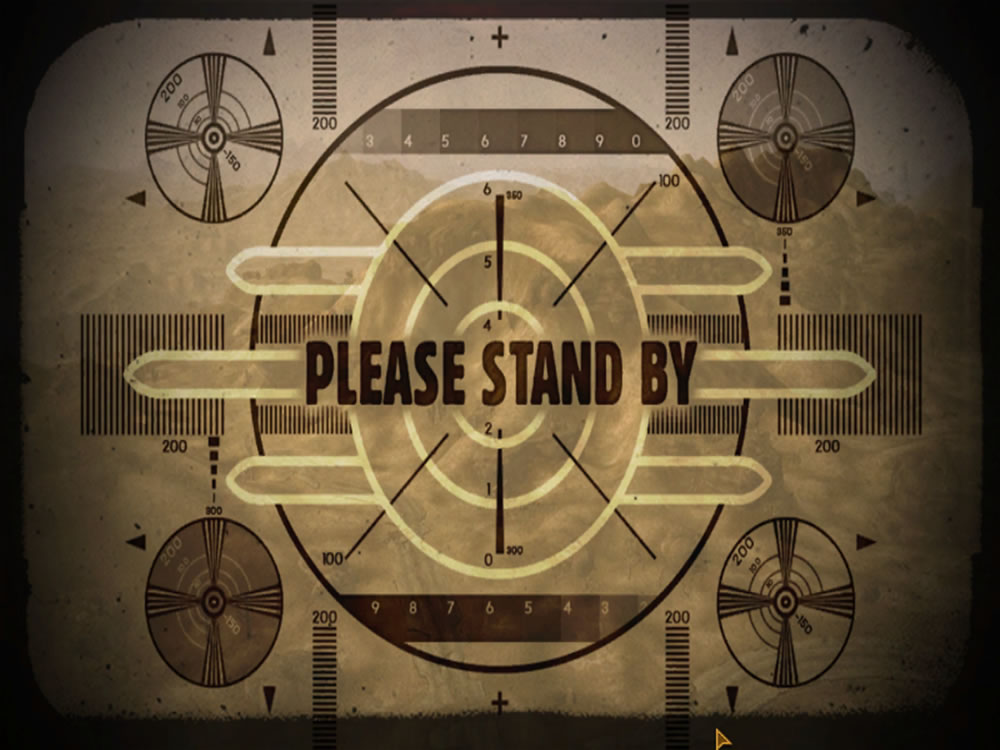
I purchased the special edition of Fallout New Vegas the day it came out. I have loved the Fallout games that came out on PC, played them repeatedly, and generally consider them to be some of the best computer games ever made.
But I was going through a lot of effort to get through Chemistry. And I knew that that distraction of a really awesome game would be a drag on my studies. So I tortured myself by leaving the game sealed for two months.
The day after Chemistry ended, Thursday the 9th, I opened it. The special edition goodies are really cool. A deck of cards, a special platinum chip, chips from various casinos in the game, a graphic novel about what happened just before the game pulls you out of a shallow grave, and the game itself. Happy, shiny! What I've been waiting for! My reward for all that hard work (I mean besides a grade and a shot at a career). I placed the disk in my drive and got ready to install.
Oh. I have to create a Steam account in order to verify the game. I didn't have a lot of luck with Steam the last time I tried one of their games, because I'm still on a dial-up connection.
Yes, I could join the rest of the world and go to some sort of speedy internet, but that's going to cost me some $240 a year to play a game I paid $80 for. Does that make sense to you?
So I start the Steam up, create a new account, one with a password I can remember, which takes some time. And then the verification procedure, after which Steam tells me that the server aren't ready. Lovely. I restart the process, made easier by the fact that I don't have to create a new log-in this time. And the servers are still too busy to acknowledge me. A third try, and I've got it! YAY for me! As Steam starts to download the game to my computer.
All six point nine gigabytes.
Which will take until the heat death of the universe on dial-up. Which is weird, because I've got those six point nine gigabytes of data on this shiny physical object sitting in my disk drive. The bit I paid for. Steam doesn't care. It wants to download the game from their servers. Well, there must be a way to get it to acknowledge the disk, right?
After a few days of poking around Steam's website, I discover that there's a command you can use if you want to install a game from disk rather than download it. Well thank God, because I was starting to get a little frustrated. This was my reward for finishing a class on Wednesday, and it's now Saturday.
Only the command doesn't work. Steam thought about it, and spit back an error at me.
So I have my disk, which I have paid for, and all that data which my computer cannot access. Thanks Steam!
Eventually, after a week of screwing around, I went to the Grotto with my CPU, (YAY, walking around with my CPU doesn't make me nervous!) and spend four hours downloading the game. Which I had on disk. Did I mention that I have the game on disk and that Steam either couldn't or wouldn't acknowledge this?
But I got the game downloaded, started it up, and it's fine. I'm playing it. But really Steam, why can't I, a moderately average user except for my dial-up connection, get the data off this shiny disk thing with all the data already downloaded onto it? And what happens if, in ten years, I want to play the game I paid for again, and Steam has gone the way of the Heat.net?
Monday, December 27, 2010
And So... We Have Weather
The East Coast got pretty well hammered with snow Sunday, and yesterday. We've got a large and fascinating accumulation of snow. But I thought I would add a few pictures to what we all know happened:
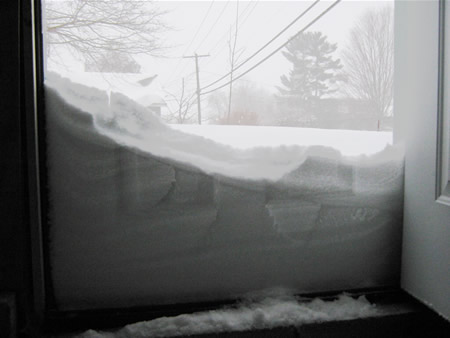
This is our back door. If you look carefully, you can see the impression of the door panels in the snow.

This is our street.

This is downtown Bennington in the midst of getting 20 inches of snow. And yes, the Geek Bar opened early.

We had some wind, as well. Although this looks like the tortured erosion on some Himalayan glacier, but it's really the roof of our extension.
I apologize for the lack of blogging in the last month. Finals, and all that sort of thing. That said, I have a few things in store: a walk-through, with pictures, of a chemistry lab in which we isolated caffeine from tea.
My trials and tribulations in getting a game to install.
Did I mention a new sale? Well, I'll get around to it soon enough.

This is our back door. If you look carefully, you can see the impression of the door panels in the snow.

This is our street.

This is downtown Bennington in the midst of getting 20 inches of snow. And yes, the Geek Bar opened early.

We had some wind, as well. Although this looks like the tortured erosion on some Himalayan glacier, but it's really the roof of our extension.
I apologize for the lack of blogging in the last month. Finals, and all that sort of thing. That said, I have a few things in store: a walk-through, with pictures, of a chemistry lab in which we isolated caffeine from tea.
My trials and tribulations in getting a game to install.
Did I mention a new sale? Well, I'll get around to it soon enough.
Saturday, November 27, 2010
A Thanksgiving Day Sale!
My much- and often-revised story "God of Chickens" will appear in the official magazine of the Australian Horror Writers Association, Midnight Echo, issue #5. The issue should be on Australian newsstands at the beginning of 2011.
This is my first non-Lovecraftian story to see notable print, and I'm rather pleased.
I suspect that will make it difficult to obtain here in the United States, but I have queried the AHWA about getting some copies. If you're interested in a copy, send me an email or make a comment to this blog post. I'll do what I can.
This is my first non-Lovecraftian story to see notable print, and I'm rather pleased.
I suspect that will make it difficult to obtain here in the United States, but I have queried the AHWA about getting some copies. If you're interested in a copy, send me an email or make a comment to this blog post. I'll do what I can.
Thursday, November 11, 2010
Armistice Day, Yet Again. What Have We Learned?
It's Armistice Day, or Veterans' Day, depending on your personal point of view. Some people have the day off, and there's probably a big sale going on.
Just take a moment and think about what today is for. Remember those who have served in the military. What did they see, what have them done? Remember those who didn't come back, whose mothers and brothers miss them. And remember those who didn't come back whole, those with post-traumatic stress disorder, or brain damage. Remember those missing an arm, a hand, or a leg. Make sure you voted to send them out for something worth that.
I don't usually post songs, but Carbon Leaf's "War Was In Color" is a good, solemn tribute, and appropriate for the day.
Just take a moment and think about what today is for. Remember those who have served in the military. What did they see, what have them done? Remember those who didn't come back, whose mothers and brothers miss them. And remember those who didn't come back whole, those with post-traumatic stress disorder, or brain damage. Remember those missing an arm, a hand, or a leg. Make sure you voted to send them out for something worth that.
I don't usually post songs, but Carbon Leaf's "War Was In Color" is a good, solemn tribute, and appropriate for the day.
Tuesday, November 9, 2010
The Dreams Haunt Me...
For two running nights, I've dreamed of playing Fallout: New Vegas. Yay. If I was the sort to believe in personification, I'd be wrapping this bad boy in tin foil.
I'm sure it has something to do with the fact that I'm rereading the best novel about Vegas ever: Tim Powers' Last Call.
But there it sits, wrapped in plastic like Laura Palmer, untouched except when I put newspapers under it to confirm the date.
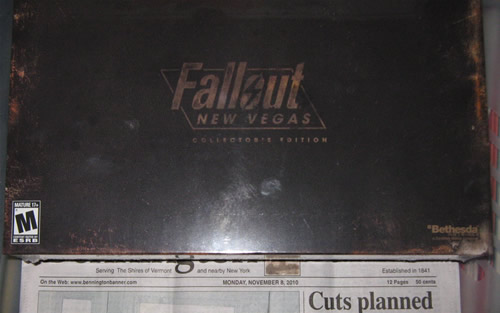
I'm sure it has something to do with the fact that I'm rereading the best novel about Vegas ever: Tim Powers' Last Call.
But there it sits, wrapped in plastic like Laura Palmer, untouched except when I put newspapers under it to confirm the date.

Sunday, October 31, 2010
Chilling Screen Moments #1: There's Something About Mary
The Kingdom is my go-to snobby horror. It’s a Danish miniseries, directed by Lars von Trier. At four and a half hours, it takes is slow, careful time developing a strange, eerie ghost story. I love The Kingdom, and generally speaking, I’m very tired of ghost stories.
The Kingdom Hospital remake really pointed out to me the amazing economy of the the original miniseries. There is no fat, no wasted scenes, no overlong belaboring of any points. Everything is there because it needs to be there. That said, it takes a little while to grow on the new viewer. You don’t even see the ghost for the first half an hour. But the story gathers momentum, and becomes an unstoppable juggernaut of creepiness.
The ghost story structure is very similar to the one in The Ring (Creepy Moment #5). One character perceives the cries of a child from beyond the grave, and sympathy compels her to help. The story is a mystery, with Mrs. Drusse discovering parts of the past and putting together what happened. Ghost stories are partially about the fear of death, and one of von Trier’s real innovations is setting the story in a hospital, perceived as many as a place of death. But more and more, ghost stories have become about the fear of dying badly.
Mary, it turned out, died very badly. Like the standard ghost, she wants to be found and buried. Chilling Moment #1 comes when we find her body.
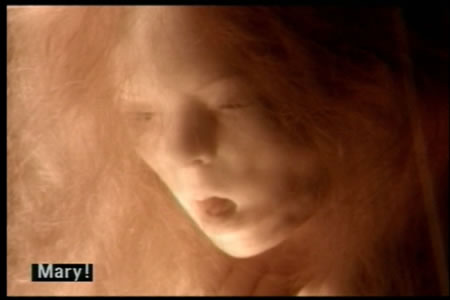
Have you ever seen someone creeped out so badly they ran out of the room? I've watched it happen at this reveal. And this was a television show; there's barely any blood, and there isn't a power tool in sight. To me, this is horror at its best; an emotional reaction elicited not through revulsion or disgust, but chilling horror born of sympathy.
The Kingdom Hospital remake really pointed out to me the amazing economy of the the original miniseries. There is no fat, no wasted scenes, no overlong belaboring of any points. Everything is there because it needs to be there. That said, it takes a little while to grow on the new viewer. You don’t even see the ghost for the first half an hour. But the story gathers momentum, and becomes an unstoppable juggernaut of creepiness.
The ghost story structure is very similar to the one in The Ring (Creepy Moment #5). One character perceives the cries of a child from beyond the grave, and sympathy compels her to help. The story is a mystery, with Mrs. Drusse discovering parts of the past and putting together what happened. Ghost stories are partially about the fear of death, and one of von Trier’s real innovations is setting the story in a hospital, perceived as many as a place of death. But more and more, ghost stories have become about the fear of dying badly.
Mary, it turned out, died very badly. Like the standard ghost, she wants to be found and buried. Chilling Moment #1 comes when we find her body.

Have you ever seen someone creeped out so badly they ran out of the room? I've watched it happen at this reveal. And this was a television show; there's barely any blood, and there isn't a power tool in sight. To me, this is horror at its best; an emotional reaction elicited not through revulsion or disgust, but chilling horror born of sympathy.
Wednesday, October 27, 2010
Chilling Screen Moments #2: You Want What?
The Dr. Who spinoff Torchwood has tried to straddle the line between action and horror, and to my mind, succeeded in being neither.
That stopped on the third season, the five-episode miniseries called Children of Earth. This series is concentrated nightmare fuel.
The aliens come down, and they aren't friendly. Unlike most Dr. Who-style aliens, we don't see what they are. They breathe a poisonous, opaque atmosphere, a very good counterpoint to the "show the monster" in The Host. The aliens are capable of wiping out humanity (shades of colonialism and War of the Worlds), and they can control our children. Children all over the Earth stop what they are doing and start chanting things. It starts with "We are here."
In Episode Four, we get down to brass tacks. A government representative negotiates with the alien, who speak with a breathy, synthesized voice. It's good and creepy. But the script really shines as the humans negotiators come to realize exactly what the aliens want.
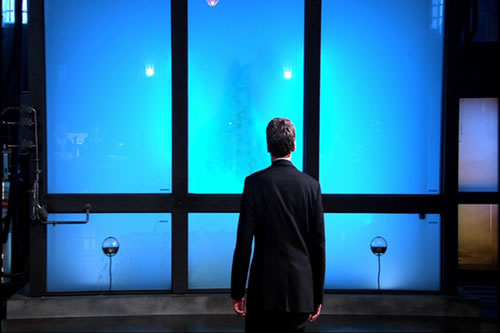
In Episode Five, we learn why, and it's worse than we thought. It is one of the most horrible, chilling revelations I've ever seen put on film. The slow negotiation builds up the tension incredibly well. Brilliant and frightening.
That stopped on the third season, the five-episode miniseries called Children of Earth. This series is concentrated nightmare fuel.
The aliens come down, and they aren't friendly. Unlike most Dr. Who-style aliens, we don't see what they are. They breathe a poisonous, opaque atmosphere, a very good counterpoint to the "show the monster" in The Host. The aliens are capable of wiping out humanity (shades of colonialism and War of the Worlds), and they can control our children. Children all over the Earth stop what they are doing and start chanting things. It starts with "We are here."
In Episode Four, we get down to brass tacks. A government representative negotiates with the alien, who speak with a breathy, synthesized voice. It's good and creepy. But the script really shines as the humans negotiators come to realize exactly what the aliens want.

In Episode Five, we learn why, and it's worse than we thought. It is one of the most horrible, chilling revelations I've ever seen put on film. The slow negotiation builds up the tension incredibly well. Brilliant and frightening.
Labels:
Chilling Moments,
Marking Time,
The Glass Babysitter
Monday, October 25, 2010
Chemistry Makes Me Sad
I love the Fallout games. They have some of the best stories being told in computer games today. The retro-future background combined with the blasted post-holocaust wasteland is simply excellent.
The most recent game has come out: Fallout: New Vegas. Being the enormously geeky fan that I am, I've bought the special edition. And I can't play it. Or rather, won't play it. With Chemistry requiring so much of my time, I simply can't afford to get sucked into a game experience that I know damn well I'm going to love. And so it sits, still in plastic, waiting for me to open it. And it's going to stay that way until the end of December.
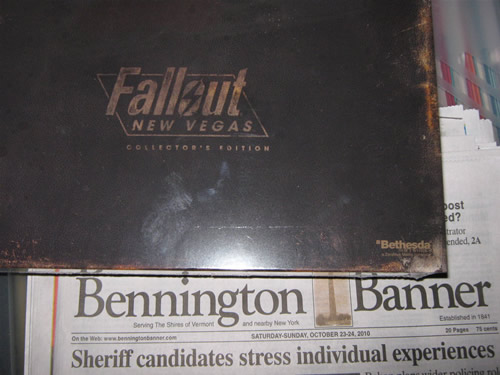
The most recent game has come out: Fallout: New Vegas. Being the enormously geeky fan that I am, I've bought the special edition. And I can't play it. Or rather, won't play it. With Chemistry requiring so much of my time, I simply can't afford to get sucked into a game experience that I know damn well I'm going to love. And so it sits, still in plastic, waiting for me to open it. And it's going to stay that way until the end of December.

Saturday, October 23, 2010
Chilling Screen Moments #3: It’s Not The Monster That Frightens Us
In many monster films, the driving source of tension is created by allowing the audience to glimpse the monster, never truly seeing it. This works quite well in Cloverfield and Alien. A monster movie truism has been that once the monster shows up on screen, the tension is gone; we know what it is.
The Host completely ignores this trope. We get a good long shot as the monster runs past us, in broad daylight, fourteen minutes into the film. Although this is a monster movie, writer/director Bong Joon-Ho knows that it’s not the appearance of the creature that is threatening, but how it acts. With photorealistic CG effects, render farms, and experts at translating concept to screen, it is much easier to create a credible monster than in the past.
The film's narrative is much more akin (and this is acknowledged by Bong Joon-Ho in his commentary) to a crime thriller than the standard monster film. A child is in peril, and her family must fight the government as well as the monster’s unpredictability and inhuman strength to get her back.
Early in the film, the monster smashes through a crowd, shredding people and creating panic. Park Gang-du grabs his daughter Hyun-Seo and runs, dragging her behind him. He falls, grabs her hand again, and takes off running again. After eight more seconds of panicked flight, he looks back... and he’s grabbed the wrong hand. The girl behind him isn’t Hyun-Seo.
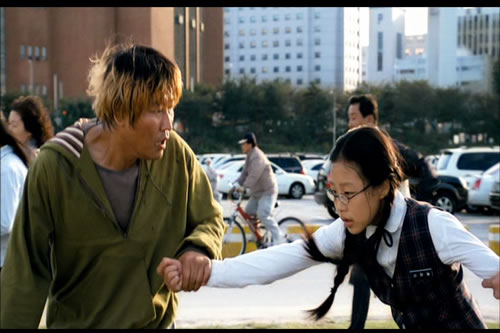
We identify the most with human moments, with emotions we understand. Gang-du’s blank expression conveys his stunned incomprehension, and for a few seconds, he’s too shocked to even be horrified. It’s a gut-wrenching moment of loss, and an presage of terrible things to come.
The Host completely ignores this trope. We get a good long shot as the monster runs past us, in broad daylight, fourteen minutes into the film. Although this is a monster movie, writer/director Bong Joon-Ho knows that it’s not the appearance of the creature that is threatening, but how it acts. With photorealistic CG effects, render farms, and experts at translating concept to screen, it is much easier to create a credible monster than in the past.
The film's narrative is much more akin (and this is acknowledged by Bong Joon-Ho in his commentary) to a crime thriller than the standard monster film. A child is in peril, and her family must fight the government as well as the monster’s unpredictability and inhuman strength to get her back.
Early in the film, the monster smashes through a crowd, shredding people and creating panic. Park Gang-du grabs his daughter Hyun-Seo and runs, dragging her behind him. He falls, grabs her hand again, and takes off running again. After eight more seconds of panicked flight, he looks back... and he’s grabbed the wrong hand. The girl behind him isn’t Hyun-Seo.

We identify the most with human moments, with emotions we understand. Gang-du’s blank expression conveys his stunned incomprehension, and for a few seconds, he’s too shocked to even be horrified. It’s a gut-wrenching moment of loss, and an presage of terrible things to come.
Wednesday, October 20, 2010
Chilling Screen Moments #4: Hans Beckert Confesses
In Fritz Lang's M, Peter Lorre plays Hans Beckert, the screen's first serial killer. Beckert preys exclusively on children, a crime so heinous that the Berlin's thieves, safecrackers, and murderers band together to catch him.
And find him they do.
Lorre's Beckert is the polar opposite of the modern, urbane serial killers such as Hannibal Lecter or Dexter Morgan. Beckert is tortured, half in denial of the things that he does. His trial, even before a kangaroo court of criminals, finally gives him the opportunity to get it out, even if his audience are likely to be his executioners.
The speech he gives defined Peter Lorre's career for the rest of his life, and it's not difficult to see why. Lorre's portrayal runs the gamut from broken to manic in the course of one dead riveting, completely chilling, three-minute speech. Serial killers have become pretty old had old hat, but Hans Beckert's mad, harrowing speech remains a chilling landmark in cinema.
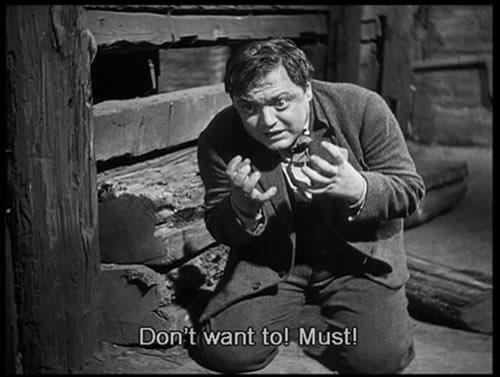
And find him they do.
Lorre's Beckert is the polar opposite of the modern, urbane serial killers such as Hannibal Lecter or Dexter Morgan. Beckert is tortured, half in denial of the things that he does. His trial, even before a kangaroo court of criminals, finally gives him the opportunity to get it out, even if his audience are likely to be his executioners.
The speech he gives defined Peter Lorre's career for the rest of his life, and it's not difficult to see why. Lorre's portrayal runs the gamut from broken to manic in the course of one dead riveting, completely chilling, three-minute speech. Serial killers have become pretty old had old hat, but Hans Beckert's mad, harrowing speech remains a chilling landmark in cinema.

Sunday, October 17, 2010
Chilling Screen Moments #5: Finally Watching Samara At Work
Structure is not an aspect of film that is often praised. Yet in a suspense, mystery or horror film, it's vital. Not just that the story itself be interesting, but that it be presented in a way that obscures exactly what is going on while keeping the viewer interested.
One of the major challenges to a ghost or monster film is how to build the tension without giving too much away. When should the terrifying entity be shown, and how can it be presented in such a way that it's not disappointing. Very often films fall down when that thing that's been chasing everyone around is suddenly revealed to be a giant carrot, or a dwarf in a rubber suit.
The Ring does this perfectly. The tension increases throughout the film, leading to many great, chilling moments. There are three "shock" moments in the film, but they are buttressed with enormous amounts of tension-building subtlety. The mystery is complex and strange, and the investigation is extraordinarily well handled. We glimpse pieces of the ghost's sad and terrible history even as we see the horrifying effects it has on the world around it. The Ring's story manages to push so many buttons; the images of a child along in a sterile medical environment, cruelty to animals, an isolated community, technophobia, medical testing, the hints that home is not as pleasant as we want it to be.
The structure of the film, the way the audience gets hints about what's going on, works beautifully. There is no Basil Exposition telling us what happened. The viewer, like the characters, piece what's going on from interviews, observations, and strange experiences. We get glimpses of frightening consequences without knowing what triggered them, except that there's a videotape involved, and people who watch it die. This lack of clarity gives the story a lot of impetus.
This all comes very terribly clear at the end when we watch what happens when someone watches the videotape we have only seen glimpses of. Who we thought was only the victim turns out to be the tormentor, and she crawls out of the television to do her horrible work. It's a hugely chilling moment, as we look at everything we've learned for the past hour and a half in a different light.
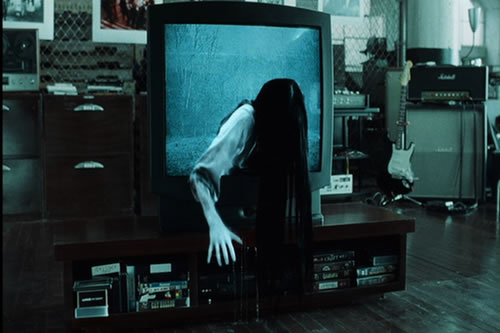
One of the major challenges to a ghost or monster film is how to build the tension without giving too much away. When should the terrifying entity be shown, and how can it be presented in such a way that it's not disappointing. Very often films fall down when that thing that's been chasing everyone around is suddenly revealed to be a giant carrot, or a dwarf in a rubber suit.
The Ring does this perfectly. The tension increases throughout the film, leading to many great, chilling moments. There are three "shock" moments in the film, but they are buttressed with enormous amounts of tension-building subtlety. The mystery is complex and strange, and the investigation is extraordinarily well handled. We glimpse pieces of the ghost's sad and terrible history even as we see the horrifying effects it has on the world around it. The Ring's story manages to push so many buttons; the images of a child along in a sterile medical environment, cruelty to animals, an isolated community, technophobia, medical testing, the hints that home is not as pleasant as we want it to be.
The structure of the film, the way the audience gets hints about what's going on, works beautifully. There is no Basil Exposition telling us what happened. The viewer, like the characters, piece what's going on from interviews, observations, and strange experiences. We get glimpses of frightening consequences without knowing what triggered them, except that there's a videotape involved, and people who watch it die. This lack of clarity gives the story a lot of impetus.
This all comes very terribly clear at the end when we watch what happens when someone watches the videotape we have only seen glimpses of. Who we thought was only the victim turns out to be the tormentor, and she crawls out of the television to do her horrible work. It's a hugely chilling moment, as we look at everything we've learned for the past hour and a half in a different light.

Tuesday, October 12, 2010
Chilling Screen Moments Moments #6: Tokyo in Flames
Anyone can take a bucket of blood and splash it on celluloid. While I enjoy the occasional gore flick, the red stuff is often at the expense of plot and interesting characters. A film (or a miniseries) that spends time and effort on building atmospheric dread interests me more. In the lead-up to Halloween, I present six screen moments that still make me catch my breath.
#6: Tokyo in Flames: Godzilla.
The original Godzilla is very much a different genre from the daikiaju genre it spawned. It is a disaster film, only the disaster happens to be a giant lizard. Unlike most other films in the genre, this concentrates not only on the giant monster wrecking the city, but what it leaves behind. After Godzilla stomps Tokyo, the camera pauses to view the the devastation, and the city in flames.
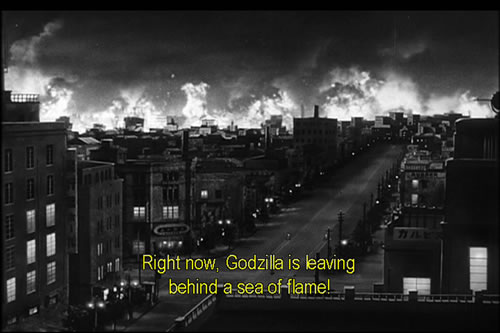
It's a very powerful moment as director Ishiro Honda concentrates on the human suffering in Godzilla's wake.
#6: Tokyo in Flames: Godzilla.
The original Godzilla is very much a different genre from the daikiaju genre it spawned. It is a disaster film, only the disaster happens to be a giant lizard. Unlike most other films in the genre, this concentrates not only on the giant monster wrecking the city, but what it leaves behind. After Godzilla stomps Tokyo, the camera pauses to view the the devastation, and the city in flames.

It's a very powerful moment as director Ishiro Honda concentrates on the human suffering in Godzilla's wake.
Labels:
Chilling Moments,
film,
Godzilla,
Marking Time
Sunday, October 3, 2010
Trees Pretty

Trees Pretty.
I'm in the midst of nuclear geometry and polar bonds, and I can't think of anything interesting to say. So enjoy my state's prettiness.
Monday, September 20, 2010
Remember when I said "I'm back"?
Well, things happened. My employment situation needs a radical change, and I have gone back to school.
I'm taking two classes in preparation for my Medical Lab Technician Certificate. The program is offered by the Community College of Vermont.
Although CCV offers this program, they don't offer all the courses necessary to complete it. Fortunately, they have an exchange program with Bennington College, for Chemistry. And I thought, hey, I'm treading the ground where Shirley Jackson, Martha Graham, Buckminster Fuller once walked. I'll be getting the benefits of a really expensive education for a low CCV price.
What I didn't realize until the first class is that BC has a very rigorous science program. One of their students went on to work on the Manhattan Project. I am one of the two people in the class that did not take Chemistry in High School (I took Biology and Physics), which is assumed for the course. I don't mind that I'm twice as old as the rest of the students, and may be older than the professor. What I do mind is that this is an accelerated class. And while it's fascinating to get a peek into the nature of physical matter and the universe, it's bloody difficult.
Thus far, this is what I've given up in my pursuit of Chemistry:
So... yeah. Not a lot of time to do things. In the last couple of days, I've started to get a handle on it, I think. I'll know when the first test rolls around in a couple of weeks.
I will be taking some pictures in lab today. In case you're interested.
I'm taking two classes in preparation for my Medical Lab Technician Certificate. The program is offered by the Community College of Vermont.
Although CCV offers this program, they don't offer all the courses necessary to complete it. Fortunately, they have an exchange program with Bennington College, for Chemistry. And I thought, hey, I'm treading the ground where Shirley Jackson, Martha Graham, Buckminster Fuller once walked. I'll be getting the benefits of a really expensive education for a low CCV price.
What I didn't realize until the first class is that BC has a very rigorous science program. One of their students went on to work on the Manhattan Project. I am one of the two people in the class that did not take Chemistry in High School (I took Biology and Physics), which is assumed for the course. I don't mind that I'm twice as old as the rest of the students, and may be older than the professor. What I do mind is that this is an accelerated class. And while it's fascinating to get a peek into the nature of physical matter and the universe, it's bloody difficult.
Thus far, this is what I've given up in my pursuit of Chemistry:
- Half my work hours
- Fencing
- Warhammer
- Writing: yes, the novel is on hold.
- Blogging
- Reading for Pleasure.
So... yeah. Not a lot of time to do things. In the last couple of days, I've started to get a handle on it, I think. I'll know when the first test rolls around in a couple of weeks.
I will be taking some pictures in lab today. In case you're interested.
Monday, August 23, 2010
20 Minutes into the Present
Max Headroom is finally on DVD. And we have it.

I like to think that I remember the show because of the writing. Max was one of the first shows about the media, and how the modern life has become more and more entwined with television. The plots were fairly standard (Ace reporter Edison Carter discovers an injustice, and gets on the air at the last moment to right the wrong). But the MacGuffins that drive the stories are very perceptive and unusual.
The conflation of television and politics is particularly relevant today, when we have television personalities holding political rallies, and getting the nation whipped up over this molehill or that. While we have not reached the point of Max Headroom where it is illegal to turn the television off, there is precious little difference between someone who can't turn their television off, and someone who won't.
The plots also usually depend on there being someone moral in a chain of events that will say "no" to the murder or imprisonment of an innocent person. For every monster out there, there is a moral individual who is able to stop them. Considering that the show is remembered for being very 'cynical' Max Headroom held the positive view that someone in the chain of command can stop an atrocity.
Part of the fascination with the show, twenty years later, is how close it comes to being real. The episode "Academy" features a show trial on Network 23, which is rather creepily reminiscent of the OJ Simpson trial.
Amazingly, in the dark future, there are few guns, and no one gets shot. I wonder if this is primarily because the writes of the show were English, rather than American. None of the show's problems have yet been solved through violence. It's the tool of terrorists and fascists.
The characters spend a lot of time watching screens and watching people interacting with screens. And not just because Max, the titular character, is confined to one. It's rather disconcerting... there's about as much face time as there is someone talking to someone over a screen. And there's more tapping on keyboards than Jessica Fletcher ever did.
Max should also be remembered for the contradiction he was. A prime-time show that critiques the media it was on. An anti-media icon that shilled for Coca-Cola. Did the producers and writers of Max sell out? Or were they cleverly co-opting a media to get their message out? It's hard to tell, but it's a lot of fun to analyze.

I like to think that I remember the show because of the writing. Max was one of the first shows about the media, and how the modern life has become more and more entwined with television. The plots were fairly standard (Ace reporter Edison Carter discovers an injustice, and gets on the air at the last moment to right the wrong). But the MacGuffins that drive the stories are very perceptive and unusual.
The conflation of television and politics is particularly relevant today, when we have television personalities holding political rallies, and getting the nation whipped up over this molehill or that. While we have not reached the point of Max Headroom where it is illegal to turn the television off, there is precious little difference between someone who can't turn their television off, and someone who won't.
The plots also usually depend on there being someone moral in a chain of events that will say "no" to the murder or imprisonment of an innocent person. For every monster out there, there is a moral individual who is able to stop them. Considering that the show is remembered for being very 'cynical' Max Headroom held the positive view that someone in the chain of command can stop an atrocity.
Part of the fascination with the show, twenty years later, is how close it comes to being real. The episode "Academy" features a show trial on Network 23, which is rather creepily reminiscent of the OJ Simpson trial.
Amazingly, in the dark future, there are few guns, and no one gets shot. I wonder if this is primarily because the writes of the show were English, rather than American. None of the show's problems have yet been solved through violence. It's the tool of terrorists and fascists.
The characters spend a lot of time watching screens and watching people interacting with screens. And not just because Max, the titular character, is confined to one. It's rather disconcerting... there's about as much face time as there is someone talking to someone over a screen. And there's more tapping on keyboards than Jessica Fletcher ever did.
Max should also be remembered for the contradiction he was. A prime-time show that critiques the media it was on. An anti-media icon that shilled for Coca-Cola. Did the producers and writers of Max sell out? Or were they cleverly co-opting a media to get their message out? It's hard to tell, but it's a lot of fun to analyze.
Labels:
Internet Lies,
nostalgia,
The Glass Babysitter
Saturday, August 21, 2010
How Do You Follow Something Like That Up?
I mean, what can I possibly say on this blog that is half, even a quarter as cool as "I had a hawk eating off my hand"?
I guess I'll have to take some time and shamelessly self-promote.
Matthew Carpenter, the man who has reviewed all my Lovecraftian work and liked it (I could say the same about Ellen Datlow, but I haven't heard her opinion of Cthulhu's Dark Cults) has once again posted good things about my work to Amazon. He likes Cthulhu's Dark Cults generally, but he once again singles out my story for discussion:
“Captains of Industry” by John Goodrich - Mr. Goodrich is just starting his career as a published author. “The Patriot” was among the many highlights of Cthulhu Unbound 1. Two impoverished immigrant factory workers, struggling to live and struggling in the battle for workers’ rights, infiltrate an industrialists’ dinner party to try to get some leverage. They run afoul of the Hermetic Order of the Silver Twilight. Once again Mr. Goodrich gives us a rousing story of superior quality. His characters come alive on the page and the action is actually heart wrenching.
I'd like to point out that I'm very proud of this. Horrifying a reader with a horror story isn't all that difficult. Getting them emotionally involved with the protagonist is more challenging. I seem to have touched Mr. Carpenter's heart. I am pleased.
I guess I'll have to take some time and shamelessly self-promote.
Matthew Carpenter, the man who has reviewed all my Lovecraftian work and liked it (I could say the same about Ellen Datlow, but I haven't heard her opinion of Cthulhu's Dark Cults) has once again posted good things about my work to Amazon. He likes Cthulhu's Dark Cults generally, but he once again singles out my story for discussion:
“Captains of Industry” by John Goodrich - Mr. Goodrich is just starting his career as a published author. “The Patriot” was among the many highlights of Cthulhu Unbound 1. Two impoverished immigrant factory workers, struggling to live and struggling in the battle for workers’ rights, infiltrate an industrialists’ dinner party to try to get some leverage. They run afoul of the Hermetic Order of the Silver Twilight. Once again Mr. Goodrich gives us a rousing story of superior quality. His characters come alive on the page and the action is actually heart wrenching.
I'd like to point out that I'm very proud of this. Horrifying a reader with a horror story isn't all that difficult. Getting them emotionally involved with the protagonist is more challenging. I seem to have touched Mr. Carpenter's heart. I am pleased.
Sunday, August 8, 2010
I Played with Birds on My Staycation
The Santa Fe Good Taste Factory was in the area, so he decided to spend a few days with us. Which is awesome. He is always fun to be with, and when someone visits, I usually look around and find something interesting and local to do. This time, I asked if he was interested in taking a lesson at the local branch of the British School of Falconry.
And he said yes.
So there we were, 11AM, scrungy as we usually are, walking up to this nice little barn. A very nice guy (Rob, I think) told us he would be our instructor, and we both hauled out our cameras and listened very carefully.
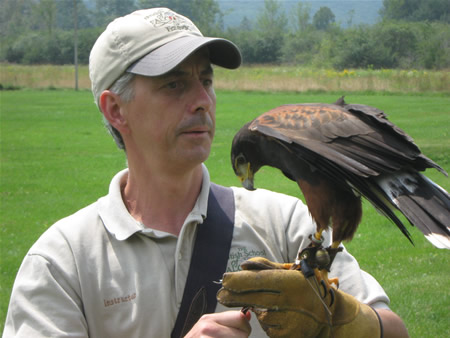
The first thing I noticed when I had a Harris Hawk sit on my wrist is that the talons are very sharp, and so is that beak. While the plumage is beautiful, and even more attractive up close, these attributes do not command immediate attention. I found it disconcerting, at first, to be so close to those huge claws on dinosaur-like feet. Did I mention his name was Mycroft? That took a couple of minutes to sink in.
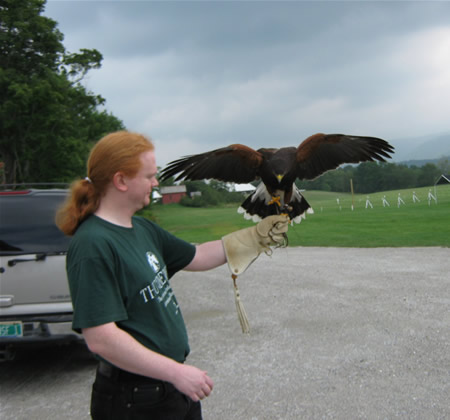
Harris Hawks are unique among raptors in that they hunt socially. This gives them a huge advantage over non-social hawks as far as falconry goes, because they won't get all pissy if two or more go after the same target. Also, they're a fairly small for a raptor--three and a half foot wingspan, between one and a half and two and a half pounds (the females are larger). But up close, Mycroft is clearly a death machine.
Attached to the bird's legs are three devices. One, some jingle bells so you know where it is. Second are the jesses, leather thongs so that you can hold onto the bird until you're ready to let him go. Think of them as bird-reigns. The bird steps onto your gloved hand, and you make a fist, clasping the jesses between your middle and ring finger. This keeps the bird in check if it decides to take off at the wrong moment. The third device is a radio transmitter with antenna, just in case the bird flies off.
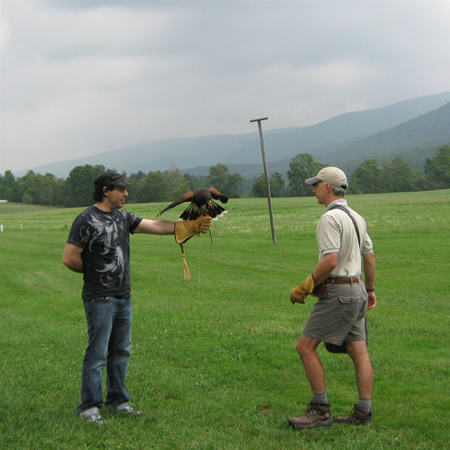
I learned that you have to walk so that the bird is always facing into the wind--otherwise they get agitated. Walking backwards is a small price to pay when you're keeping the Massive Sharp Beak of Death calm.
Once we learned the basic tips, we were ready to receive the bird. Rob would cast the bird, it would go to a downwind perch. Then I raised my gloved arm, and Mycroft took off, and headed for me. Mycroft, apparently, flies lower than many of the usual birds, getting a bit of ground effect. Then he perfectly, every time, came up and landed on my arm. Stuck the landing even as he grabbed the little beefy treat the trainer put on my glove as a reward. Watching a bird land on your arm is really amazing, so much energy conserved, and yet each one is absolutely perfect (unless I screw it up).
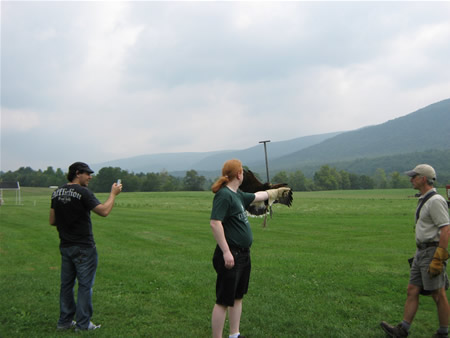
After a couple of landings, we learned to cast. This is something like throwing a rock or a baseball. You hold the jesses for a quarter second as you throw, giving the hawk a bit of a boost. So we managed to get the hawk off my glove and back a couple of times, and each time, Mycroft got a tasty treat.
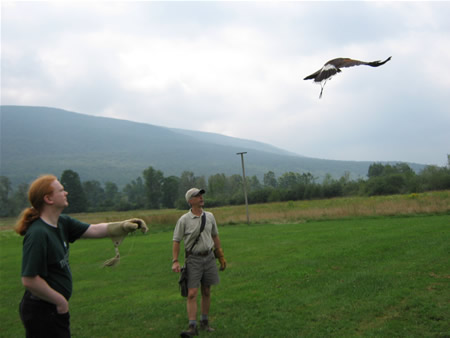
We did a little ranging after that, walking along, and the bird would make quick flying hops from, tree branch to tree branch to keep up with us. We could hear it only because of the jingle bells attached to its legs. So when you hear the jingle over your roof... it's probably not reindeer.
Our hour was over far too quickly. Falconry is hugely entertaining, because you've got this raptor doing its thing off your wrist. That last bit is incredibly strange, because we seldom get close to birds, let alone anything as magnificent as a medium-sized raptor. I got a real appreciation for the complexity of hawk flight, as well as for the difficulty in training hawks.
I don't think I'll want to participate in the hunting aspect of the sport. It's the next logical step, and the next lesson, but I'm a lot more interested in the bird for itself than it coming back with a squirrel.

Special thanks to the Queen of Science for the wonderful pictures.
And he said yes.
So there we were, 11AM, scrungy as we usually are, walking up to this nice little barn. A very nice guy (Rob, I think) told us he would be our instructor, and we both hauled out our cameras and listened very carefully.

The first thing I noticed when I had a Harris Hawk sit on my wrist is that the talons are very sharp, and so is that beak. While the plumage is beautiful, and even more attractive up close, these attributes do not command immediate attention. I found it disconcerting, at first, to be so close to those huge claws on dinosaur-like feet. Did I mention his name was Mycroft? That took a couple of minutes to sink in.

Harris Hawks are unique among raptors in that they hunt socially. This gives them a huge advantage over non-social hawks as far as falconry goes, because they won't get all pissy if two or more go after the same target. Also, they're a fairly small for a raptor--three and a half foot wingspan, between one and a half and two and a half pounds (the females are larger). But up close, Mycroft is clearly a death machine.
Attached to the bird's legs are three devices. One, some jingle bells so you know where it is. Second are the jesses, leather thongs so that you can hold onto the bird until you're ready to let him go. Think of them as bird-reigns. The bird steps onto your gloved hand, and you make a fist, clasping the jesses between your middle and ring finger. This keeps the bird in check if it decides to take off at the wrong moment. The third device is a radio transmitter with antenna, just in case the bird flies off.

I learned that you have to walk so that the bird is always facing into the wind--otherwise they get agitated. Walking backwards is a small price to pay when you're keeping the Massive Sharp Beak of Death calm.
Once we learned the basic tips, we were ready to receive the bird. Rob would cast the bird, it would go to a downwind perch. Then I raised my gloved arm, and Mycroft took off, and headed for me. Mycroft, apparently, flies lower than many of the usual birds, getting a bit of ground effect. Then he perfectly, every time, came up and landed on my arm. Stuck the landing even as he grabbed the little beefy treat the trainer put on my glove as a reward. Watching a bird land on your arm is really amazing, so much energy conserved, and yet each one is absolutely perfect (unless I screw it up).

After a couple of landings, we learned to cast. This is something like throwing a rock or a baseball. You hold the jesses for a quarter second as you throw, giving the hawk a bit of a boost. So we managed to get the hawk off my glove and back a couple of times, and each time, Mycroft got a tasty treat.

We did a little ranging after that, walking along, and the bird would make quick flying hops from, tree branch to tree branch to keep up with us. We could hear it only because of the jingle bells attached to its legs. So when you hear the jingle over your roof... it's probably not reindeer.
Our hour was over far too quickly. Falconry is hugely entertaining, because you've got this raptor doing its thing off your wrist. That last bit is incredibly strange, because we seldom get close to birds, let alone anything as magnificent as a medium-sized raptor. I got a real appreciation for the complexity of hawk flight, as well as for the difficulty in training hawks.
I don't think I'll want to participate in the hunting aspect of the sport. It's the next logical step, and the next lesson, but I'm a lot more interested in the bird for itself than it coming back with a squirrel.

Special thanks to the Queen of Science for the wonderful pictures.
Tuesday, July 27, 2010
Finally... I'm BACK!
It's been a difficult month, and I apologize for being remiss on this blog. But now I'm back.
One of the more notable joys of June was discovering a new favorite (non-Sondheim, but he's in his own category so other writers have a chance) musical.
Probably some of you have seen Reese Witherspoon in Legally Blonde. It's quite possible you don't approve of the trend of making musicals out of films. I know that generally speaking I don't, although said trend did bring us Spamalot, and I'm willing to forgive a lot for that.
That said, the Legally Blonde musical is fast-rising on my list of favorite musicals. Yes the songs are clever and entertaining, but the central message of the work as a whole, which is emphasized very differently from the film. The plot is the same; vapid but intelligent girl goes to Harvard law to chase boyfriend and discovers that she likes being a lawyer.
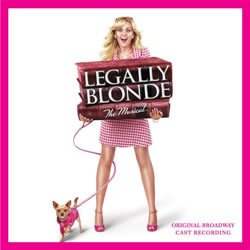
In the film, she succeeds because she is true to herself; succeeds with the tasks using her intelligence, social networking, and other feminine skills that the other law students discount. The musical, however, shifts that. Elle succeeds because she works hard. She is thrown one obstacle after another, and she learns to settle down, apply herself, and hammers each problem until it breaks. I can't think of the last time any media had that message, and it's one that really needs to come up more.
Films tend to tell us to be true to ourselves, and if we do that, we will achieve our dreams. Very seldom is there prolonged effort involved, usually just a moment of endurance, and sometimes one of inspiration. Elle Woods discovers when she pursues one goal that what she achieves in that pursuit is better than what she thought she wanted. She isn't staying "true to herself" she's finding new challenges to overcome, and discovers the joy of self-fulfillment. We need more texts like this. Especially ones with clever, catchy songs.
One of the more notable joys of June was discovering a new favorite (non-Sondheim, but he's in his own category so other writers have a chance) musical.
Probably some of you have seen Reese Witherspoon in Legally Blonde. It's quite possible you don't approve of the trend of making musicals out of films. I know that generally speaking I don't, although said trend did bring us Spamalot, and I'm willing to forgive a lot for that.
That said, the Legally Blonde musical is fast-rising on my list of favorite musicals. Yes the songs are clever and entertaining, but the central message of the work as a whole, which is emphasized very differently from the film. The plot is the same; vapid but intelligent girl goes to Harvard law to chase boyfriend and discovers that she likes being a lawyer.

In the film, she succeeds because she is true to herself; succeeds with the tasks using her intelligence, social networking, and other feminine skills that the other law students discount. The musical, however, shifts that. Elle succeeds because she works hard. She is thrown one obstacle after another, and she learns to settle down, apply herself, and hammers each problem until it breaks. I can't think of the last time any media had that message, and it's one that really needs to come up more.
Films tend to tell us to be true to ourselves, and if we do that, we will achieve our dreams. Very seldom is there prolonged effort involved, usually just a moment of endurance, and sometimes one of inspiration. Elle Woods discovers when she pursues one goal that what she achieves in that pursuit is better than what she thought she wanted. She isn't staying "true to herself" she's finding new challenges to overcome, and discovers the joy of self-fulfillment. We need more texts like this. Especially ones with clever, catchy songs.
Monday, July 5, 2010
Comfort Reading
Every now and then, I like to blow an afternoon reading at TVtropes.org. They have an enormous collection of trite plot devices and characters that often show up in various media. I lavish a fair amount of love and attention on esoterica. In the extreme, it seems because even TVtropes doesn't have a precise fit for a trope that makes up some of my comfort reading.
I love the riddling trickster's tomb. I love tombs and crypts in which the setup and execution would have baffled NASA engineers, where the concealed 10 x 10 pit traps are still in perfect working condition after centuries, and even millennia.
There's a bit of my affection for ancient Egypt tied up in this. After all, the characters are pludering a trapped tomb, loading up on gold and other grave goods. There's a touch of archaeology, even if it is prying the gold letters out of the walls and melting them down.
The tomb of the riddler seldom appears outside of the RPG media-form. Teasing riddles have little effect on a novel reader. Readers aren't motivated to solve the riddle because it doesn't save them grief; they're just along for the ride. And if they do solve it, they're still saddled with the characters' stupid ball until the author decides its time.
At the heart of the trope lies an arrogance; that those entering the dungeon are too stupid to figure out the traps without help, and that even if the Evil Overlord gives them hints, they're still going to die to the fiendish traps.
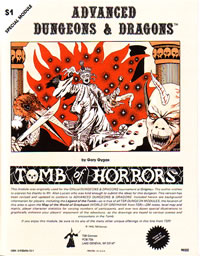 The trope began with Gary Gygax's Tomb of Horrors. Tomb of Horrors was an enormously influential adventure, one of the first modular adventures ever released. People tend to strongly divide between loving and hating it. It was designed to test the skills of overproud D&D players, but there's a lot of personality in it. The reader gets a sense of the builder's nasty sense of humor as well as their capacity for random mayhem.
The trope began with Gary Gygax's Tomb of Horrors. Tomb of Horrors was an enormously influential adventure, one of the first modular adventures ever released. People tend to strongly divide between loving and hating it. It was designed to test the skills of overproud D&D players, but there's a lot of personality in it. The reader gets a sense of the builder's nasty sense of humor as well as their capacity for random mayhem.
Tomb of Horrors was quite successful. And with success came imitation. The next adventure in the "S" series was Lawrence Schick's White Plume Mountain, which reinforced many of the concepts, including giving the players a riddle to help them figure out the mind-boggling traps that were laid for them.
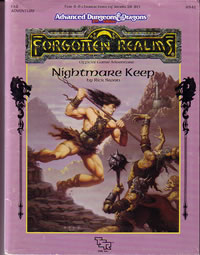 A further exploration of the theme was Nightmare Keep. Like several vertions of the trope to come, this adventure set out to make a bigger and nastier Tomb of Horrors . Included are the strange poetic traps, the same distinctive undead horror waiting at the end. However, it's a bit overblown, the traps rather self-consciously weird rather than traps for individuals to get themselves killed by being greedy or careless.
A further exploration of the theme was Nightmare Keep. Like several vertions of the trope to come, this adventure set out to make a bigger and nastier Tomb of Horrors . Included are the strange poetic traps, the same distinctive undead horror waiting at the end. However, it's a bit overblown, the traps rather self-consciously weird rather than traps for individuals to get themselves killed by being greedy or careless.
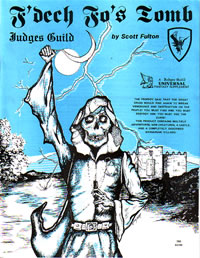 Other imitations include third-party adventures such as F'Deck Fo's Tomb. I often champion third-party variations on a theme because individuals removed from the editorial control of a single entity (in this case TSR) often have wider mematic interpretation that brings something new and fresh to the trope. This is not the case here. With the adventure-writing in its infancy, some publishers seemed willing to publish anything. This adventure would never have gotten past the editors at TSR.
Other imitations include third-party adventures such as F'Deck Fo's Tomb. I often champion third-party variations on a theme because individuals removed from the editorial control of a single entity (in this case TSR) often have wider mematic interpretation that brings something new and fresh to the trope. This is not the case here. With the adventure-writing in its infancy, some publishers seemed willing to publish anything. This adventure would never have gotten past the editors at TSR.
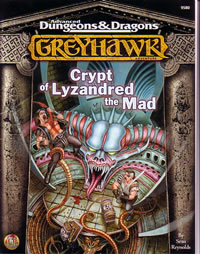 Rising RPG star Sean Reynolds wrote his own bigger, badder riddle tomb for second edition Dungeons and Dragons adventure The Crypt of Lyzandred the Mad. Like many bigger versions of the original, this feels like the creator (Lyzandred, alternately Reynolds) is trying too hard. The riddles rely heavily on logic and word puzzles, sometimes straight-out asking the riddle, giving the feel of an enormous pop quiz. the Tomb of Horrors' Acererak was trying to kill the characters. From a read-through, it feels like Lyzandred is grading them.
Rising RPG star Sean Reynolds wrote his own bigger, badder riddle tomb for second edition Dungeons and Dragons adventure The Crypt of Lyzandred the Mad. Like many bigger versions of the original, this feels like the creator (Lyzandred, alternately Reynolds) is trying too hard. The riddles rely heavily on logic and word puzzles, sometimes straight-out asking the riddle, giving the feel of an enormous pop quiz. the Tomb of Horrors' Acererak was trying to kill the characters. From a read-through, it feels like Lyzandred is grading them.
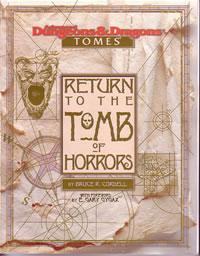 In the waning years of AD&D 2nd ed, the Return to the Tomb of Horrors mega-adventure was published. Both a sequel and an enormous expansion of the original, this gave the original TOH a definite location as well as an ecology. Not only has the tomb attracted a cult of worshippers, but the builder's designs in creating such a deadly location come into very large, interdimensional view. Of course, it's up to the adventuring party to foil the mighty plot. The author, Bruce Cordell, did a good if not completely satisfying job with this expansion. It won best adventure for the year, and is certainly one of the most overarchingly grand adventures I've ever read.
In the waning years of AD&D 2nd ed, the Return to the Tomb of Horrors mega-adventure was published. Both a sequel and an enormous expansion of the original, this gave the original TOH a definite location as well as an ecology. Not only has the tomb attracted a cult of worshippers, but the builder's designs in creating such a deadly location come into very large, interdimensional view. Of course, it's up to the adventuring party to foil the mighty plot. The author, Bruce Cordell, did a good if not completely satisfying job with this expansion. It won best adventure for the year, and is certainly one of the most overarchingly grand adventures I've ever read.
Gygax went topped his own meatgrinder dungeon with Lejendary Adventures' Necropolis, later converted to D&D 3rd edition by Necromancer Games. If the Tomb of Horrors was a meat-grinder, Necropolis is astonishing. The sophistication and resourcefulness of D&D players had increased, at least in Gary's opinion. However, it also shows a a definite change in Gary's style, and the expected style of play. Where Tomb of Horrors is a location with no background, Necropolis is set in a pseudo-Egyptian location, with a large number of encounters that contribute to a broad storyline leading up to the assault on the tomb of SetRahotep.
With the advent of third edition and the Open Game Licence, third parties were allowed to publish their own adventures in the D&D system. Unlike the earlier efforts, this time some extremely talented people got into writing adventures. Some of them wrote riddling trap tombs, and again the memetic mutation carries them to different yet interesating places, adding to the richness of the trope.
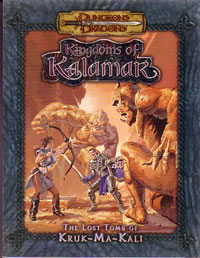 KenzerCo's Lost Tomb of Kruk-Ma-Kali is one of my favorite meldings of the old meat-grinding trope with more in-depth playstyle. While the killing traps remain, the tomb is presented not only with an ecology surrounding it, it also has a political history. The end of the text also deals with the political and cultural repercussions of the players actions, allowing the adventure to become part of a larger tapestry. But this adventure made me wonder: if Kruk-Ma-Kali was basically a Hobgoblin Genghis Khan, why the blue frell did his followers dump his mortal remains into a supremely elaborate trap-tomb rather than paying for a resurrection?
KenzerCo's Lost Tomb of Kruk-Ma-Kali is one of my favorite meldings of the old meat-grinding trope with more in-depth playstyle. While the killing traps remain, the tomb is presented not only with an ecology surrounding it, it also has a political history. The end of the text also deals with the political and cultural repercussions of the players actions, allowing the adventure to become part of a larger tapestry. But this adventure made me wonder: if Kruk-Ma-Kali was basically a Hobgoblin Genghis Khan, why the blue frell did his followers dump his mortal remains into a supremely elaborate trap-tomb rather than paying for a resurrection?
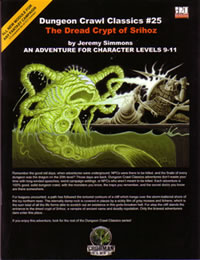 Dread Crypt of Srihoz is part of Goodman Games' Dungeon Crawl Classics series. These deliberately call back to adventures of first edition D&D, right down to a cardstock cover with the dungeon map printed in blue ink. Goodman's writers clearly know and love the dungeon tropes they are playing with. The Dread Crypt is another deathtrap dungeon, but the writers have understood the need for the perception of a single guiding hand behind its construction. The tomb's locations serve a purpose, even if this will not be apparent to the adventurers, the cohesive design allows the Game Master to view it as an expression of the individual who built it. Of particular interest is the fact that it lampshades other riddling labyrinth lords by offering riddles that don't help the players at all. A very perceptive stroke.
Dread Crypt of Srihoz is part of Goodman Games' Dungeon Crawl Classics series. These deliberately call back to adventures of first edition D&D, right down to a cardstock cover with the dungeon map printed in blue ink. Goodman's writers clearly know and love the dungeon tropes they are playing with. The Dread Crypt is another deathtrap dungeon, but the writers have understood the need for the perception of a single guiding hand behind its construction. The tomb's locations serve a purpose, even if this will not be apparent to the adventurers, the cohesive design allows the Game Master to view it as an expression of the individual who built it. Of particular interest is the fact that it lampshades other riddling labyrinth lords by offering riddles that don't help the players at all. A very perceptive stroke.
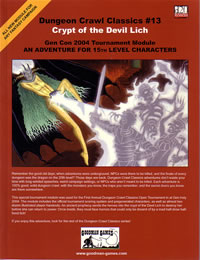 One of the earliest Dungeon Crawl Classics was produced as a direct homage to Tomb of Horrors. Called the Dread Crypt of the Devil-Lich, it was a tournament adventure, just as the original TOH was. Imitating the older adventure, it contained many strange traps designed to test the adventurers' ability against deadly hangman's riddles. Its failing is that it does not feel like a cohesive adventure. Each trap is radically different from the other, never revealing the likes of the dislikes of the tomb's designer. Still, the adventure is very solid, and the climactic battle with the eponymous devil-lich looks both deadly and intriguing, especially after the party has waded through more than a dozen rooms of nightmare traps.
One of the earliest Dungeon Crawl Classics was produced as a direct homage to Tomb of Horrors. Called the Dread Crypt of the Devil-Lich, it was a tournament adventure, just as the original TOH was. Imitating the older adventure, it contained many strange traps designed to test the adventurers' ability against deadly hangman's riddles. Its failing is that it does not feel like a cohesive adventure. Each trap is radically different from the other, never revealing the likes of the dislikes of the tomb's designer. Still, the adventure is very solid, and the climactic battle with the eponymous devil-lich looks both deadly and intriguing, especially after the party has waded through more than a dozen rooms of nightmare traps.
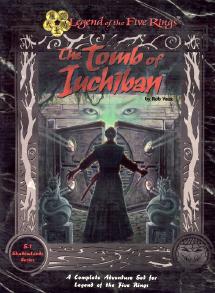 One of the best and most unusual homages to the Tomb of Horrors is Tomb of Iuchiban for the Legend of the Five Rings game. TOH tributes seldom appear outside of DUngeons and Dragons, and L5R's Oriental setting is not one I would have thought that lent itself to the trope. Rob Vaux does so magnificently, however, creating an ever-changing maze of traps that range from simple but deadly to complex, magically weird meat grinders. This adventure is a real pleasure: well written, original, and cohesive.
One of the best and most unusual homages to the Tomb of Horrors is Tomb of Iuchiban for the Legend of the Five Rings game. TOH tributes seldom appear outside of DUngeons and Dragons, and L5R's Oriental setting is not one I would have thought that lent itself to the trope. Rob Vaux does so magnificently, however, creating an ever-changing maze of traps that range from simple but deadly to complex, magically weird meat grinders. This adventure is a real pleasure: well written, original, and cohesive.
And yes, now there is a fourth edition version of the Tomb coming out this month. Although 4th ed hasn't thrilled me so far (I haven't actually played since 2nd), I think that may be the impetus for my most recent return to deathtrap tombs. I'm actually more interested in the Erol Otus-illustrated Tomb of the Blind God (Goodman Games again).
This is my 'comfort' reading, imagining the D&D party trapped and besieged in a stone crypt loaded with traps and monsters. At best, they fire my imagination, wondering how characters (and players) would face the illogical hangmans' riddles they are presented with.
I love the riddling trickster's tomb. I love tombs and crypts in which the setup and execution would have baffled NASA engineers, where the concealed 10 x 10 pit traps are still in perfect working condition after centuries, and even millennia.
There's a bit of my affection for ancient Egypt tied up in this. After all, the characters are pludering a trapped tomb, loading up on gold and other grave goods. There's a touch of archaeology, even if it is prying the gold letters out of the walls and melting them down.
The tomb of the riddler seldom appears outside of the RPG media-form. Teasing riddles have little effect on a novel reader. Readers aren't motivated to solve the riddle because it doesn't save them grief; they're just along for the ride. And if they do solve it, they're still saddled with the characters' stupid ball until the author decides its time.
At the heart of the trope lies an arrogance; that those entering the dungeon are too stupid to figure out the traps without help, and that even if the Evil Overlord gives them hints, they're still going to die to the fiendish traps.
 The trope began with Gary Gygax's Tomb of Horrors. Tomb of Horrors was an enormously influential adventure, one of the first modular adventures ever released. People tend to strongly divide between loving and hating it. It was designed to test the skills of overproud D&D players, but there's a lot of personality in it. The reader gets a sense of the builder's nasty sense of humor as well as their capacity for random mayhem.
The trope began with Gary Gygax's Tomb of Horrors. Tomb of Horrors was an enormously influential adventure, one of the first modular adventures ever released. People tend to strongly divide between loving and hating it. It was designed to test the skills of overproud D&D players, but there's a lot of personality in it. The reader gets a sense of the builder's nasty sense of humor as well as their capacity for random mayhem.Tomb of Horrors was quite successful. And with success came imitation. The next adventure in the "S" series was Lawrence Schick's White Plume Mountain, which reinforced many of the concepts, including giving the players a riddle to help them figure out the mind-boggling traps that were laid for them.
 A further exploration of the theme was Nightmare Keep. Like several vertions of the trope to come, this adventure set out to make a bigger and nastier Tomb of Horrors . Included are the strange poetic traps, the same distinctive undead horror waiting at the end. However, it's a bit overblown, the traps rather self-consciously weird rather than traps for individuals to get themselves killed by being greedy or careless.
A further exploration of the theme was Nightmare Keep. Like several vertions of the trope to come, this adventure set out to make a bigger and nastier Tomb of Horrors . Included are the strange poetic traps, the same distinctive undead horror waiting at the end. However, it's a bit overblown, the traps rather self-consciously weird rather than traps for individuals to get themselves killed by being greedy or careless. Other imitations include third-party adventures such as F'Deck Fo's Tomb. I often champion third-party variations on a theme because individuals removed from the editorial control of a single entity (in this case TSR) often have wider mematic interpretation that brings something new and fresh to the trope. This is not the case here. With the adventure-writing in its infancy, some publishers seemed willing to publish anything. This adventure would never have gotten past the editors at TSR.
Other imitations include third-party adventures such as F'Deck Fo's Tomb. I often champion third-party variations on a theme because individuals removed from the editorial control of a single entity (in this case TSR) often have wider mematic interpretation that brings something new and fresh to the trope. This is not the case here. With the adventure-writing in its infancy, some publishers seemed willing to publish anything. This adventure would never have gotten past the editors at TSR. Rising RPG star Sean Reynolds wrote his own bigger, badder riddle tomb for second edition Dungeons and Dragons adventure The Crypt of Lyzandred the Mad. Like many bigger versions of the original, this feels like the creator (Lyzandred, alternately Reynolds) is trying too hard. The riddles rely heavily on logic and word puzzles, sometimes straight-out asking the riddle, giving the feel of an enormous pop quiz. the Tomb of Horrors' Acererak was trying to kill the characters. From a read-through, it feels like Lyzandred is grading them.
Rising RPG star Sean Reynolds wrote his own bigger, badder riddle tomb for second edition Dungeons and Dragons adventure The Crypt of Lyzandred the Mad. Like many bigger versions of the original, this feels like the creator (Lyzandred, alternately Reynolds) is trying too hard. The riddles rely heavily on logic and word puzzles, sometimes straight-out asking the riddle, giving the feel of an enormous pop quiz. the Tomb of Horrors' Acererak was trying to kill the characters. From a read-through, it feels like Lyzandred is grading them. In the waning years of AD&D 2nd ed, the Return to the Tomb of Horrors mega-adventure was published. Both a sequel and an enormous expansion of the original, this gave the original TOH a definite location as well as an ecology. Not only has the tomb attracted a cult of worshippers, but the builder's designs in creating such a deadly location come into very large, interdimensional view. Of course, it's up to the adventuring party to foil the mighty plot. The author, Bruce Cordell, did a good if not completely satisfying job with this expansion. It won best adventure for the year, and is certainly one of the most overarchingly grand adventures I've ever read.
In the waning years of AD&D 2nd ed, the Return to the Tomb of Horrors mega-adventure was published. Both a sequel and an enormous expansion of the original, this gave the original TOH a definite location as well as an ecology. Not only has the tomb attracted a cult of worshippers, but the builder's designs in creating such a deadly location come into very large, interdimensional view. Of course, it's up to the adventuring party to foil the mighty plot. The author, Bruce Cordell, did a good if not completely satisfying job with this expansion. It won best adventure for the year, and is certainly one of the most overarchingly grand adventures I've ever read.Gygax went topped his own meatgrinder dungeon with Lejendary Adventures' Necropolis, later converted to D&D 3rd edition by Necromancer Games. If the Tomb of Horrors was a meat-grinder, Necropolis is astonishing. The sophistication and resourcefulness of D&D players had increased, at least in Gary's opinion. However, it also shows a a definite change in Gary's style, and the expected style of play. Where Tomb of Horrors is a location with no background, Necropolis is set in a pseudo-Egyptian location, with a large number of encounters that contribute to a broad storyline leading up to the assault on the tomb of SetRahotep.
With the advent of third edition and the Open Game Licence, third parties were allowed to publish their own adventures in the D&D system. Unlike the earlier efforts, this time some extremely talented people got into writing adventures. Some of them wrote riddling trap tombs, and again the memetic mutation carries them to different yet interesating places, adding to the richness of the trope.
 KenzerCo's Lost Tomb of Kruk-Ma-Kali is one of my favorite meldings of the old meat-grinding trope with more in-depth playstyle. While the killing traps remain, the tomb is presented not only with an ecology surrounding it, it also has a political history. The end of the text also deals with the political and cultural repercussions of the players actions, allowing the adventure to become part of a larger tapestry. But this adventure made me wonder: if Kruk-Ma-Kali was basically a Hobgoblin Genghis Khan, why the blue frell did his followers dump his mortal remains into a supremely elaborate trap-tomb rather than paying for a resurrection?
KenzerCo's Lost Tomb of Kruk-Ma-Kali is one of my favorite meldings of the old meat-grinding trope with more in-depth playstyle. While the killing traps remain, the tomb is presented not only with an ecology surrounding it, it also has a political history. The end of the text also deals with the political and cultural repercussions of the players actions, allowing the adventure to become part of a larger tapestry. But this adventure made me wonder: if Kruk-Ma-Kali was basically a Hobgoblin Genghis Khan, why the blue frell did his followers dump his mortal remains into a supremely elaborate trap-tomb rather than paying for a resurrection? Dread Crypt of Srihoz is part of Goodman Games' Dungeon Crawl Classics series. These deliberately call back to adventures of first edition D&D, right down to a cardstock cover with the dungeon map printed in blue ink. Goodman's writers clearly know and love the dungeon tropes they are playing with. The Dread Crypt is another deathtrap dungeon, but the writers have understood the need for the perception of a single guiding hand behind its construction. The tomb's locations serve a purpose, even if this will not be apparent to the adventurers, the cohesive design allows the Game Master to view it as an expression of the individual who built it. Of particular interest is the fact that it lampshades other riddling labyrinth lords by offering riddles that don't help the players at all. A very perceptive stroke.
Dread Crypt of Srihoz is part of Goodman Games' Dungeon Crawl Classics series. These deliberately call back to adventures of first edition D&D, right down to a cardstock cover with the dungeon map printed in blue ink. Goodman's writers clearly know and love the dungeon tropes they are playing with. The Dread Crypt is another deathtrap dungeon, but the writers have understood the need for the perception of a single guiding hand behind its construction. The tomb's locations serve a purpose, even if this will not be apparent to the adventurers, the cohesive design allows the Game Master to view it as an expression of the individual who built it. Of particular interest is the fact that it lampshades other riddling labyrinth lords by offering riddles that don't help the players at all. A very perceptive stroke. One of the earliest Dungeon Crawl Classics was produced as a direct homage to Tomb of Horrors. Called the Dread Crypt of the Devil-Lich, it was a tournament adventure, just as the original TOH was. Imitating the older adventure, it contained many strange traps designed to test the adventurers' ability against deadly hangman's riddles. Its failing is that it does not feel like a cohesive adventure. Each trap is radically different from the other, never revealing the likes of the dislikes of the tomb's designer. Still, the adventure is very solid, and the climactic battle with the eponymous devil-lich looks both deadly and intriguing, especially after the party has waded through more than a dozen rooms of nightmare traps.
One of the earliest Dungeon Crawl Classics was produced as a direct homage to Tomb of Horrors. Called the Dread Crypt of the Devil-Lich, it was a tournament adventure, just as the original TOH was. Imitating the older adventure, it contained many strange traps designed to test the adventurers' ability against deadly hangman's riddles. Its failing is that it does not feel like a cohesive adventure. Each trap is radically different from the other, never revealing the likes of the dislikes of the tomb's designer. Still, the adventure is very solid, and the climactic battle with the eponymous devil-lich looks both deadly and intriguing, especially after the party has waded through more than a dozen rooms of nightmare traps. One of the best and most unusual homages to the Tomb of Horrors is Tomb of Iuchiban for the Legend of the Five Rings game. TOH tributes seldom appear outside of DUngeons and Dragons, and L5R's Oriental setting is not one I would have thought that lent itself to the trope. Rob Vaux does so magnificently, however, creating an ever-changing maze of traps that range from simple but deadly to complex, magically weird meat grinders. This adventure is a real pleasure: well written, original, and cohesive.
One of the best and most unusual homages to the Tomb of Horrors is Tomb of Iuchiban for the Legend of the Five Rings game. TOH tributes seldom appear outside of DUngeons and Dragons, and L5R's Oriental setting is not one I would have thought that lent itself to the trope. Rob Vaux does so magnificently, however, creating an ever-changing maze of traps that range from simple but deadly to complex, magically weird meat grinders. This adventure is a real pleasure: well written, original, and cohesive. And yes, now there is a fourth edition version of the Tomb coming out this month. Although 4th ed hasn't thrilled me so far (I haven't actually played since 2nd), I think that may be the impetus for my most recent return to deathtrap tombs. I'm actually more interested in the Erol Otus-illustrated Tomb of the Blind God (Goodman Games again).
This is my 'comfort' reading, imagining the D&D party trapped and besieged in a stone crypt loaded with traps and monsters. At best, they fire my imagination, wondering how characters (and players) would face the illogical hangmans' riddles they are presented with.
Wednesday, June 23, 2010
Gunfighter Nation
"By the terms of the Frontier Myth, once imperial war was conflated with savage war, both sides become subject to the logic of massacre. The savage enemy kills and terrorizes without limit or discrimination in order to exterminate or drive out the civilized race. The civilized race learns to respond in kind, partly from outrage at the atrocities it has suffered, partly from recognition that imitation and mastery of the savages' methods way the best way to defeat them. A cycle of massacre and revenge is thus inaugurated that drives both sides toward a war of extermination. Only an American victory can prevent actual genocide: the savage enemy would indeed exterminate all the civilized race, but the civilized carry massacre only as far as necessary to subjugate the savage. To achieve victory in such a war, Americans are entitled and indeed required to use any and all means, including massacre, terrorism, and torture."
Slotkin, Richard; Gunfighter Nation (1992) p. 112
Slotkin, Richard; Gunfighter Nation (1992) p. 112
Thursday, June 10, 2010
Hide Your Women and Lock up the Fried Chicken!

Cthulhu's Dark Cults is finally out. You should totally order it.
If you want to know about my story, "Captains of Industry" then head over to editor David Conyers' blog in which he hand gives each author a little time to discuss their story (I'm at the bottom) and a little snippet from each story. The inestimable Stephen Gilberts provides the delightful cover.
I'm really fascinated by the human side of horror. Monsters are interesting, but their relationship to the people in the story is what will really pull the audience in. David was surprised when I turned in a story without any of Lovecraft's brilliantly detailed alien horrors. But with the title Cthulhu's Dark Cults I figured that the human cultists should be the focus of the stories.
Wednesday, May 26, 2010
HP Lovecraft and the Non-Euclidian Plot
I like a Cthulhu Mythos pastiche as much as anyone. Probably more, I've got shelves full of Chaosium anthologies, as well as four volumes of Japanese stories in honor of Lovecraft, as well as various small press books of stories in imitation of Lovecraft. Hell, I've even got a couple books of August Derleth's imitations of Lovecraft.
I do have a crap limit. Lovecraft shows up in strange and unexpected places... including children's television. The animated superhero show Justice League broadcast a two-parter "The Terror Beyond" on November 15, 2003. I Netflicked the disk, and watched it.
It's terrible.
The plot revolves around Dr. Fate and Aquaman joining forces with Solomon Grundy in order to seal a breach between out dimension and that of Icthultu, a noxious horror that has a mysterious link to Hawkwoman's homeworld of Thanageria. There's some fighting, because the Justice League aren't just going to ask Fate and Aquaman what they're doing. Once that's cleared up, they take a trip (in the second half-hour) to Icthultu's dimension to kick his ass.
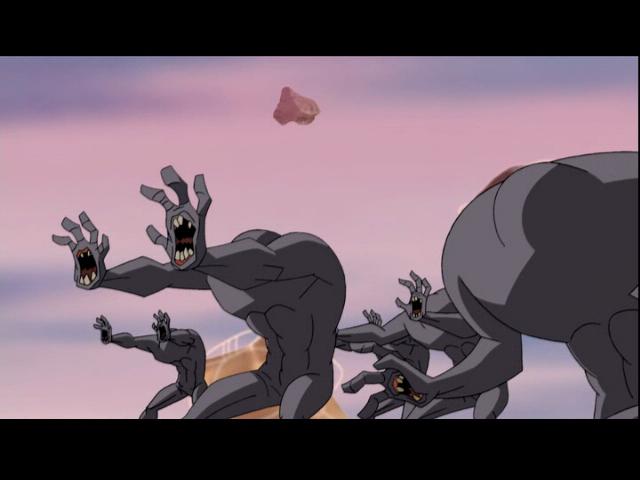 Now I'm going to start with the pictures. Some of Icthultu's defenders are gray, headless creatures with screaming mouths in their hands. Ramsey Campbell, are you paying attention?
Now I'm going to start with the pictures. Some of Icthultu's defenders are gray, headless creatures with screaming mouths in their hands. Ramsey Campbell, are you paying attention?
With the gray IP violations defeated, the team separates, Fate, Grundy and Hawkgirl going to face Icthultu. We are treated to a good reveal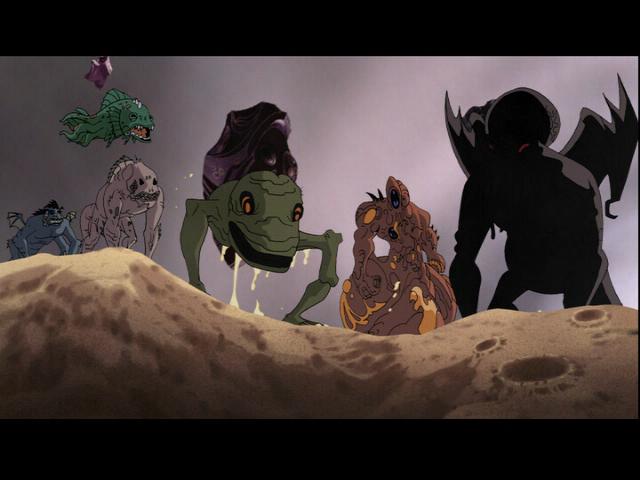 of the tentacled face of Icthultu glowering down on our heroes. Atheist Hawkgirl tells us that her Thanagarian people used to worship Icthultu, which gave them philosophy and agriculture in exchange for their souls. But the price was too high, and they stopped believing. They beat up some star-spawn (look at the right hand of the picture, that's practically Cthulhu in silhouette)
of the tentacled face of Icthultu glowering down on our heroes. Atheist Hawkgirl tells us that her Thanagarian people used to worship Icthultu, which gave them philosophy and agriculture in exchange for their souls. But the price was too high, and they stopped believing. They beat up some star-spawn (look at the right hand of the picture, that's practically Cthulhu in silhouette) 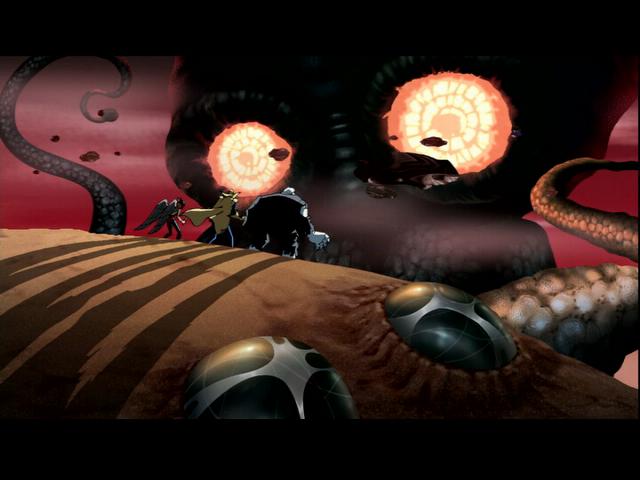 , and get right up to in Icthultu's grill.
, and get right up to in Icthultu's grill.
In a G-rated nod to hard-core pseudo-Lovecraftian Japanese porn, Hawkgirl is grabbed by tentacles. Golly, who saw that coming?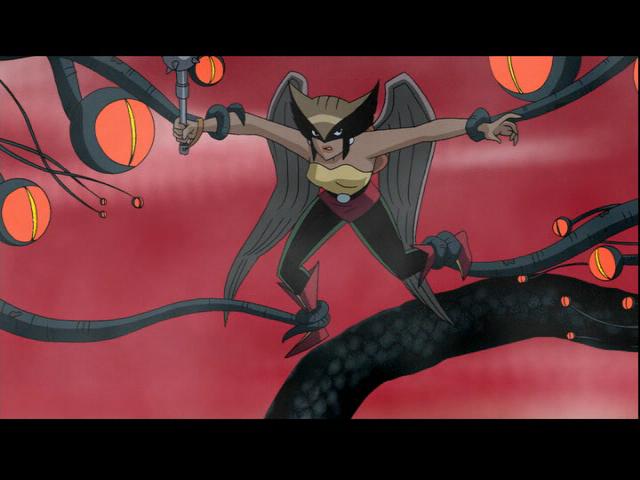 She's held spread-eagle (haw haw!) before the burning eyes of Icthultu, and banter is exchanged.
She's held spread-eagle (haw haw!) before the burning eyes of Icthultu, and banter is exchanged. 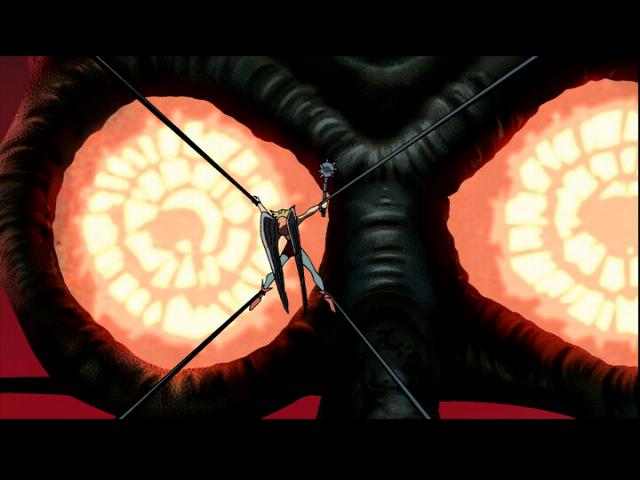
As the great Old One is distracted, Solomon Grundy gets into its head, and runs down icky corridors fighting off weird alien antibodies. I think he's in Icthultu's brain, the landscape looks like the neurons from the episode of Futurama when Fry does the same thing. But it turns out that there's something living inside Icthultu's brain... a giant monster!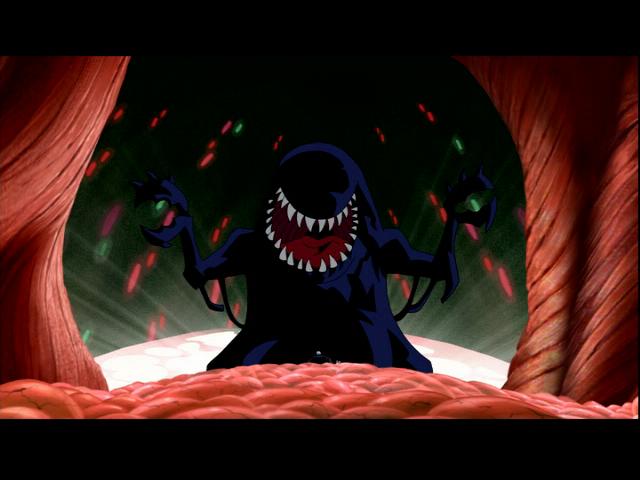
Rawr!
Fortunately, Icthultu (as voiced by Rob Zombie) is a enormous wimp. Grundy snaps off its claw, stabs it a few times, and that does the trick.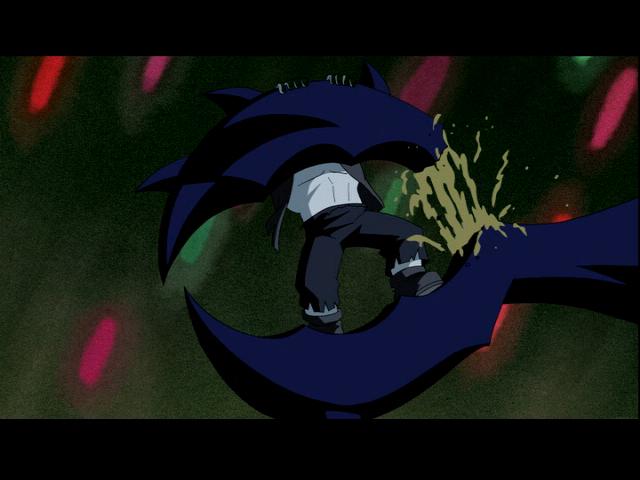
He probably stabs two feet of claw into a creature that's taller than a three-story building. But that seems to do it for Icthultu, and down it goes.
Grundy having done the mighty deed, is dying, and Hawkgirl comforts him. When Grundy asks if he is going to meet his soul, Hawkgirl chokes back the reply that she doesn't believe in them. THEN WHAT WAS THE BIG PRICE ICTHULTU EXTRACTED FROM YOUR PEOPLE, LADY? She believed in her ancestors' souls enough to build up a big mad-on at Icthultu for stealing them.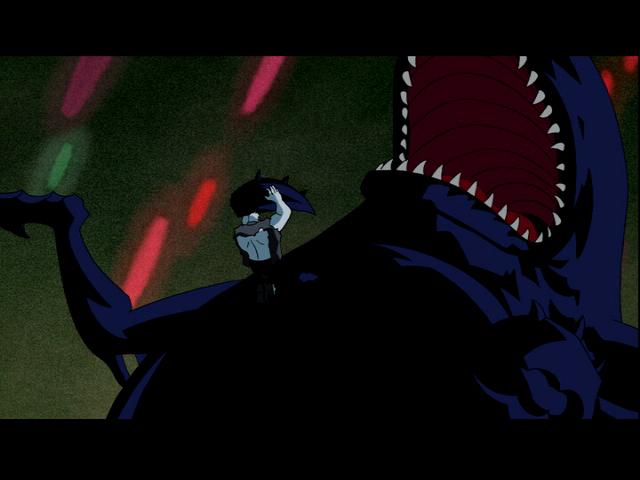
The non-Euclidian arc of this story, serving mainly to give us fights (some do feature some pretty smooth moves), drives me nuts. Superman and Wonder Woman are too hasty to ask Dr. Fate and Aquaman for explanations, and barrel right into a ritual that's keeping the Icthultu out of our dimension. But if they'd asked, the episode would have been over in fifteen minutes. Hawkgirl's comforting of Solomon is touching, but the moment is ruined because she's reversed her stance on souls in the last ten minutes.
Not all Lovecraft references are interesting, and not all are worth dissecting.
I do have a crap limit. Lovecraft shows up in strange and unexpected places... including children's television. The animated superhero show Justice League broadcast a two-parter "The Terror Beyond" on November 15, 2003. I Netflicked the disk, and watched it.
It's terrible.
The plot revolves around Dr. Fate and Aquaman joining forces with Solomon Grundy in order to seal a breach between out dimension and that of Icthultu, a noxious horror that has a mysterious link to Hawkwoman's homeworld of Thanageria. There's some fighting, because the Justice League aren't just going to ask Fate and Aquaman what they're doing. Once that's cleared up, they take a trip (in the second half-hour) to Icthultu's dimension to kick his ass.
 Now I'm going to start with the pictures. Some of Icthultu's defenders are gray, headless creatures with screaming mouths in their hands. Ramsey Campbell, are you paying attention?
Now I'm going to start with the pictures. Some of Icthultu's defenders are gray, headless creatures with screaming mouths in their hands. Ramsey Campbell, are you paying attention?With the gray IP violations defeated, the team separates, Fate, Grundy and Hawkgirl going to face Icthultu. We are treated to a good reveal
 of the tentacled face of Icthultu glowering down on our heroes. Atheist Hawkgirl tells us that her Thanagarian people used to worship Icthultu, which gave them philosophy and agriculture in exchange for their souls. But the price was too high, and they stopped believing. They beat up some star-spawn (look at the right hand of the picture, that's practically Cthulhu in silhouette)
of the tentacled face of Icthultu glowering down on our heroes. Atheist Hawkgirl tells us that her Thanagarian people used to worship Icthultu, which gave them philosophy and agriculture in exchange for their souls. But the price was too high, and they stopped believing. They beat up some star-spawn (look at the right hand of the picture, that's practically Cthulhu in silhouette)  , and get right up to in Icthultu's grill.
, and get right up to in Icthultu's grill.In a G-rated nod to hard-core pseudo-Lovecraftian Japanese porn, Hawkgirl is grabbed by tentacles. Golly, who saw that coming?
 She's held spread-eagle (haw haw!) before the burning eyes of Icthultu, and banter is exchanged.
She's held spread-eagle (haw haw!) before the burning eyes of Icthultu, and banter is exchanged. 
As the great Old One is distracted, Solomon Grundy gets into its head, and runs down icky corridors fighting off weird alien antibodies. I think he's in Icthultu's brain, the landscape looks like the neurons from the episode of Futurama when Fry does the same thing. But it turns out that there's something living inside Icthultu's brain... a giant monster!

Rawr!
Fortunately, Icthultu (as voiced by Rob Zombie) is a enormous wimp. Grundy snaps off its claw, stabs it a few times, and that does the trick.

He probably stabs two feet of claw into a creature that's taller than a three-story building. But that seems to do it for Icthultu, and down it goes.
Grundy having done the mighty deed, is dying, and Hawkgirl comforts him. When Grundy asks if he is going to meet his soul, Hawkgirl chokes back the reply that she doesn't believe in them. THEN WHAT WAS THE BIG PRICE ICTHULTU EXTRACTED FROM YOUR PEOPLE, LADY? She believed in her ancestors' souls enough to build up a big mad-on at Icthultu for stealing them.

The non-Euclidian arc of this story, serving mainly to give us fights (some do feature some pretty smooth moves), drives me nuts. Superman and Wonder Woman are too hasty to ask Dr. Fate and Aquaman for explanations, and barrel right into a ritual that's keeping the Icthultu out of our dimension. But if they'd asked, the episode would have been over in fifteen minutes. Hawkgirl's comforting of Solomon is touching, but the moment is ruined because she's reversed her stance on souls in the last ten minutes.
Not all Lovecraft references are interesting, and not all are worth dissecting.
Subscribe to:
Comments (Atom)